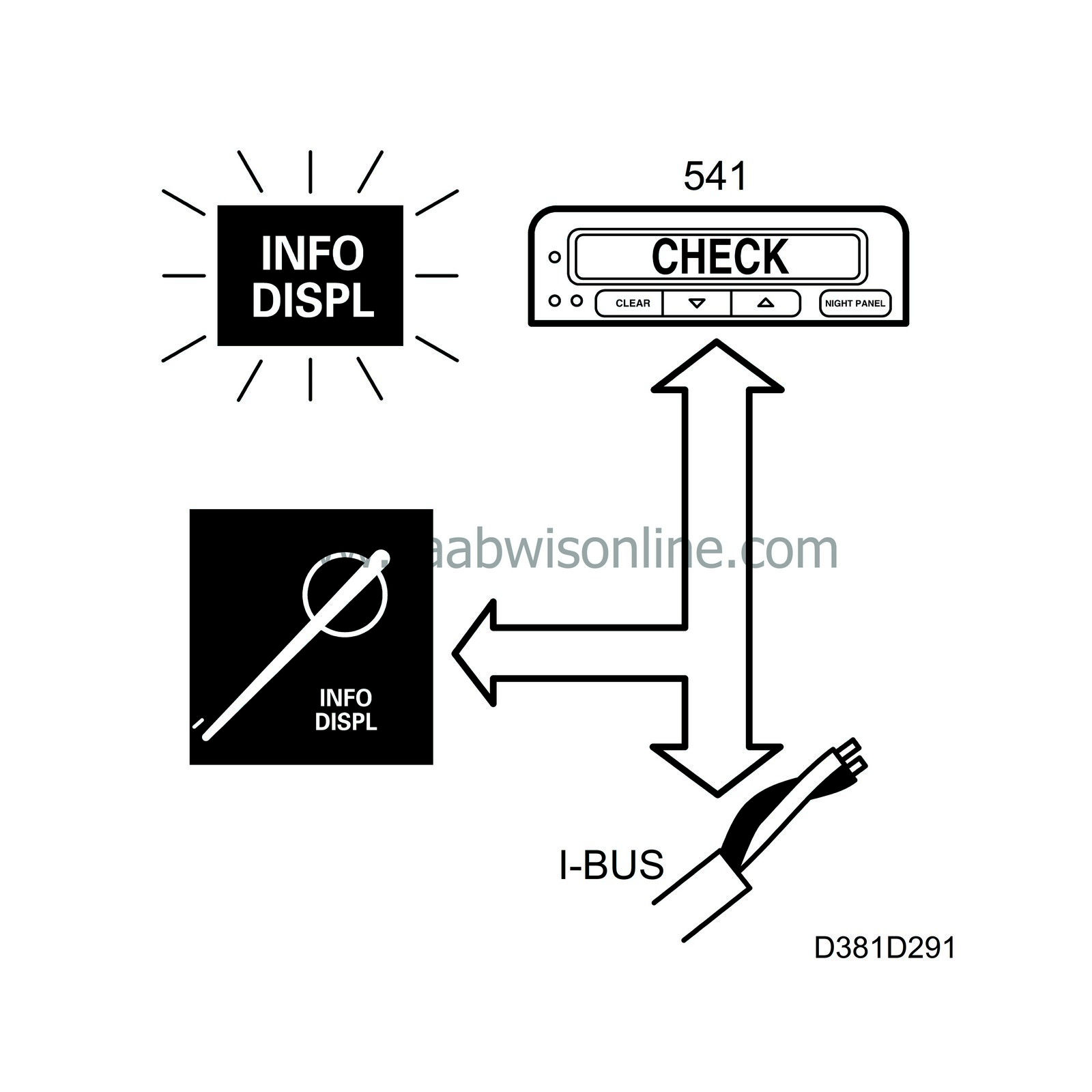Warning and indicator lamps
| Warning and indicator lamps |

The INFO DISPL lamp comes on when a message is shown on SID. The lamp is powered with +15 from the main instrument unit and is grounded by the main instrument unit control module. SID sends continuous bus information INFO DISPL, unit ON/OFF.
On receiving INFO DISPL ON, the control module grounds the output for the lamp which then lights up.
The main instrument unit lights this lamp for 3 seconds when the ignition is switched on.
Diagnostics
The function has no diagnostics.| Central warning lamp |


The central warning lamp lights up when a fault occurs in a system having to do with the car's safety.
The lamp is powered with +15 from the main instrument unit and is internally grounded by the main instrument unit when any of the following warning or indicator lamps come on:
| • |
Warning lamp, AIRBAG
|
|
| • |
Engine oil pressure warning lamp
|
|
| • |
Warning lamp, charging
|
|
| • |
Warning lamp, brake fluid level
|
|
| • |
Warning lamp, handbrake
|
|
| • |
ABS warning lamp
|
|
The handbrake lamp lights the central warning lamp if the speed passes 5 km/h from a speed below 5 km/h.
Common to the above lamps is that they are supplied with current (+15 circuit) in the main instrument unit and grounded through the relevant component/system.
The central warning lamp also lights up when:
| • |
Coolant temperature exceeds 129°C
|
|
At the same time as the central warning lamp comes on, the main instrument unit will send bus information to SID to activate an acoustic signal. This will not happen when the ignition is turned on as this will only test the lamps. The engine speed must be higher than 310 rpm for this request.
Diagnostics
The function has no diagnostics.| Engine oil pressure warning lamp |
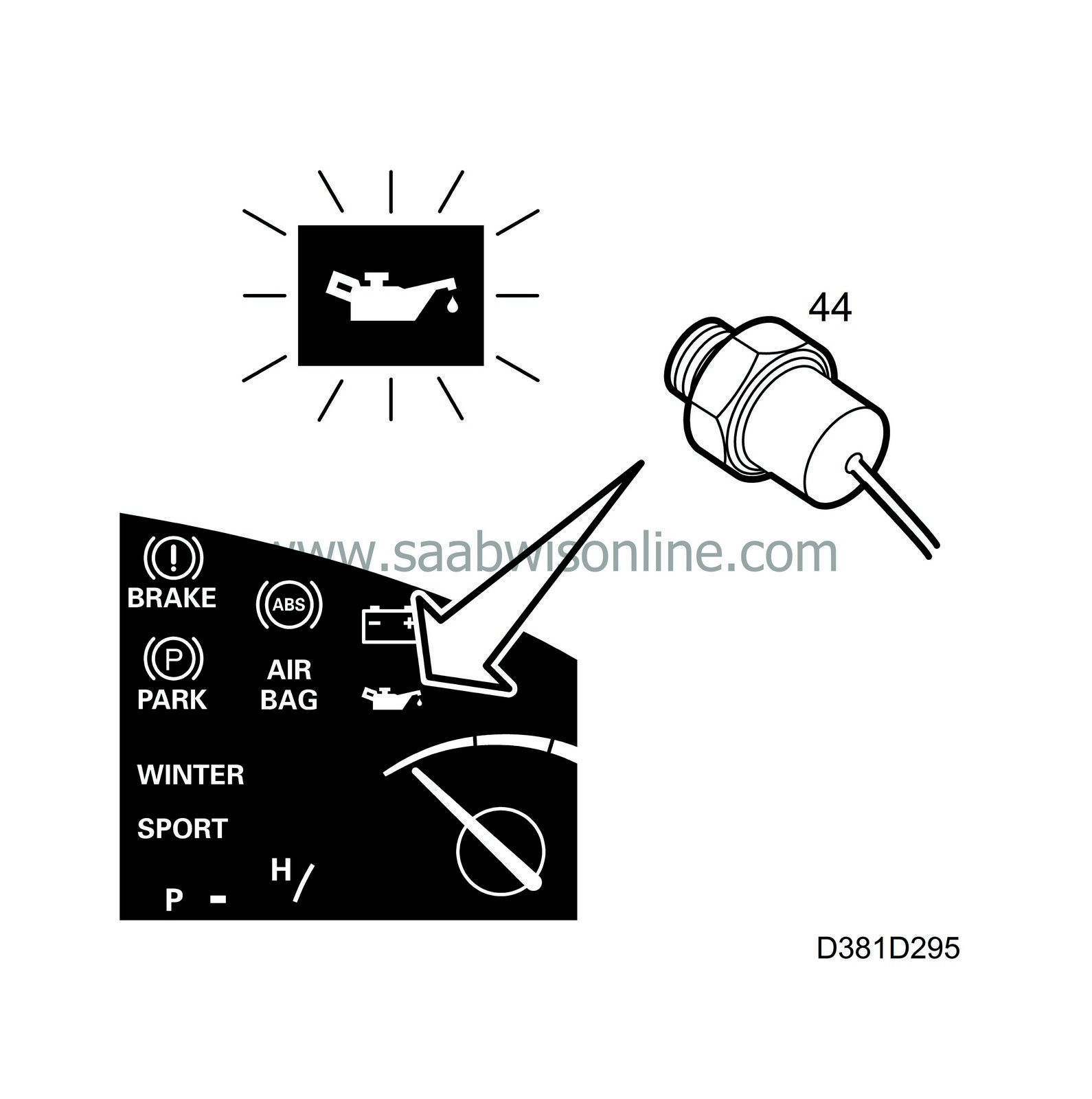
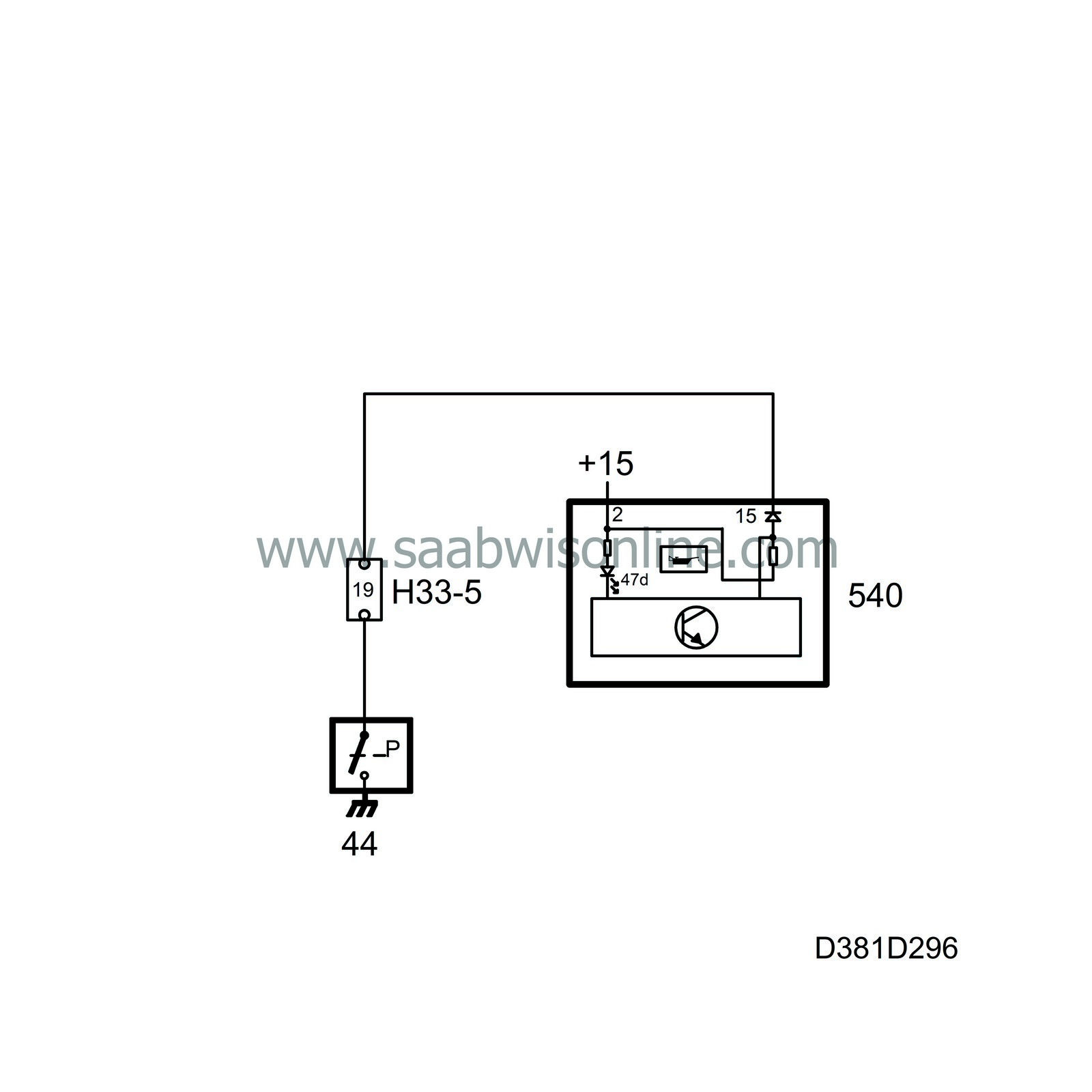
The oil pressure warning lamp is located in the top right-hand corner. It warns the driver when engine oil pressure is too low.
The lamp is supplied with current in the main instrument unit and grounded via terminal 2 (K20) of the oil pressure sensor.
If the oil pressure is below 0.3-0.5 bar, the oil pressure sensor will close, pin 15 in the main instrument unit will be grounded and the control module will turn on the lamp. At the same time as the central warning lamp comes on, MIU will send a request to SID to activate an acoustic signal if the engine speed is above 310 rpm.
Diagnostics
The function has no diagnostics.| Warning lamp, charging |
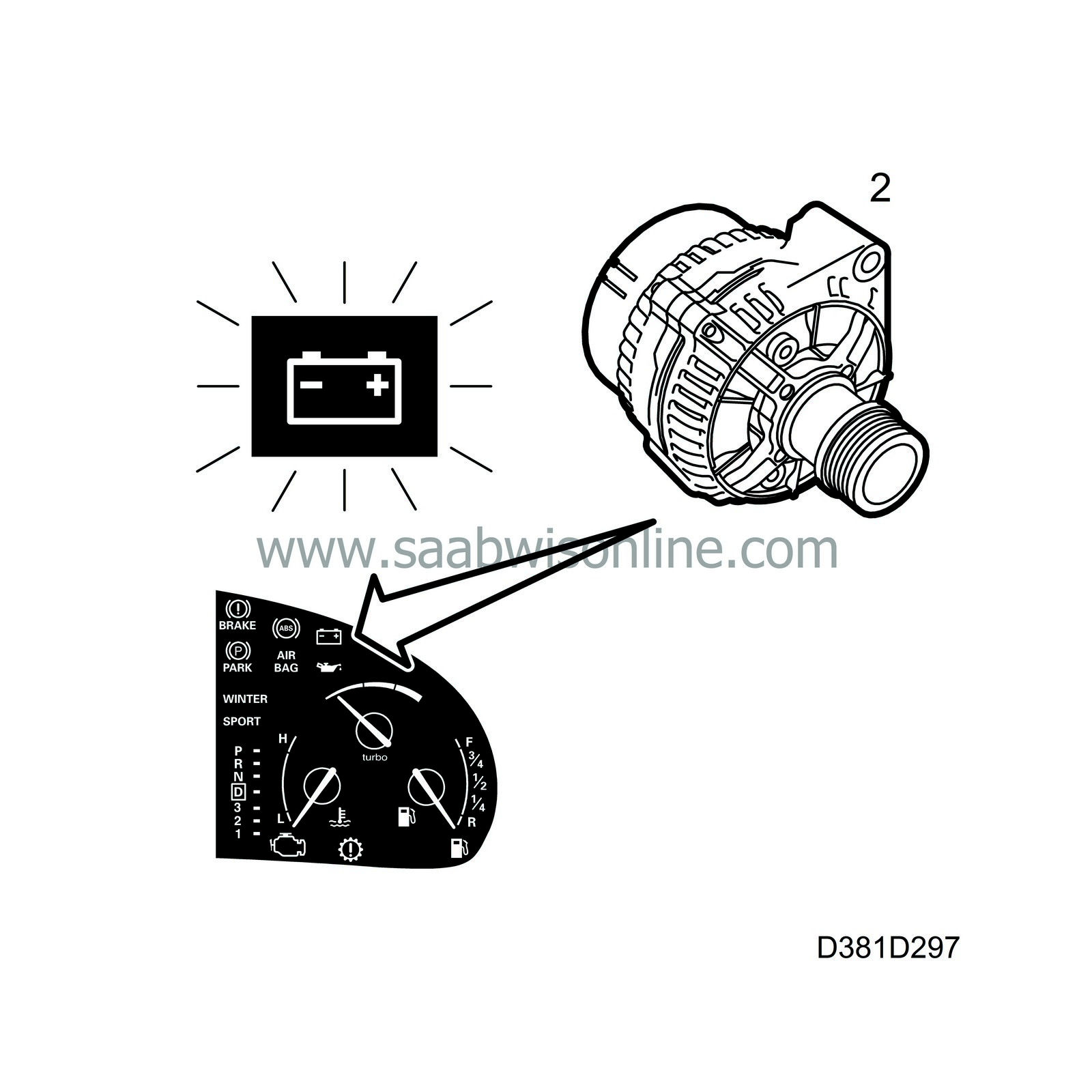
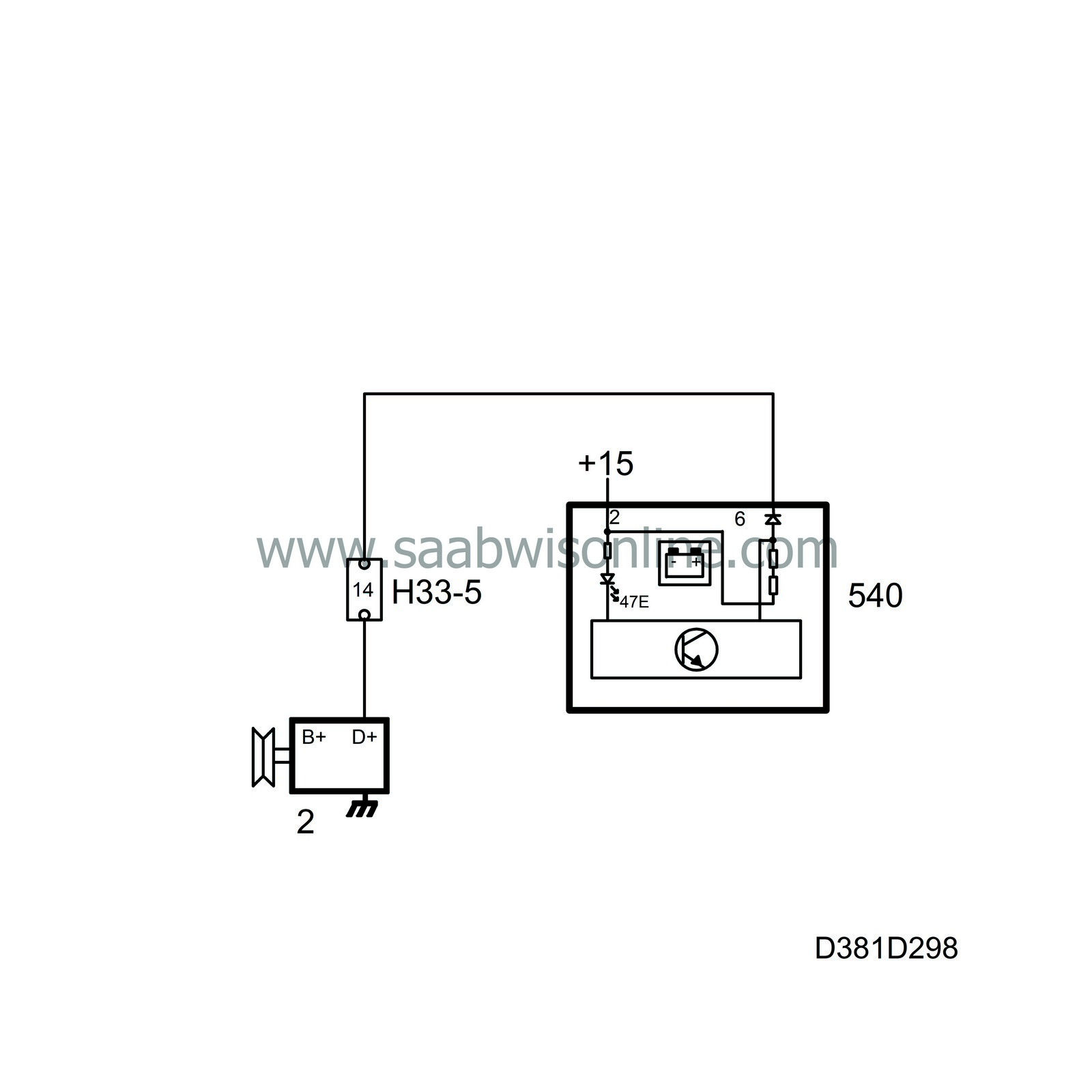
The charge warning lamp is situated in the top right-hand corner and informs the driver whether or not the generator is charging.
The lamp is powered by the main instrument unit and is grounded internally by the main instrument unit.
If the generator is not rotating or if it is not charging for some reason, pin 6 on the main instrument unit will be grounded via the regulator through the generator field winding, whereby the lamp will come on. Meanwhile, the central warning lamp will come on and at engine speeds above 310 rpm, MIU will send a request to SID to activate the acoustic signal.
When the generator is charging, its D+ and B+ terminals will have the same voltage. The MIU input will then be supplied with B+ voltage, whereby the control unit will turn off the lamp.
Diagnostics
The function has no diagnostics.| Warning lamp, AIRBAG |
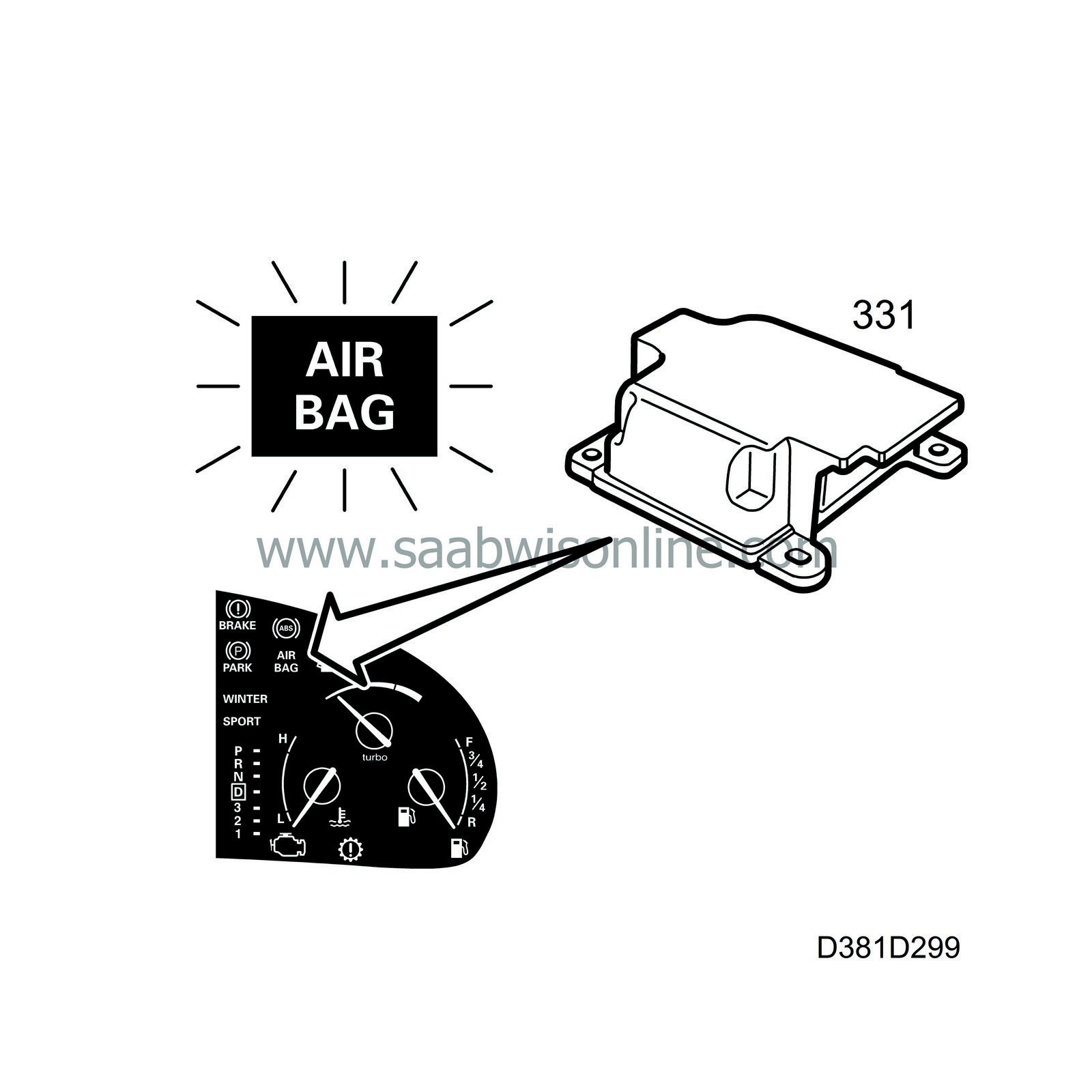
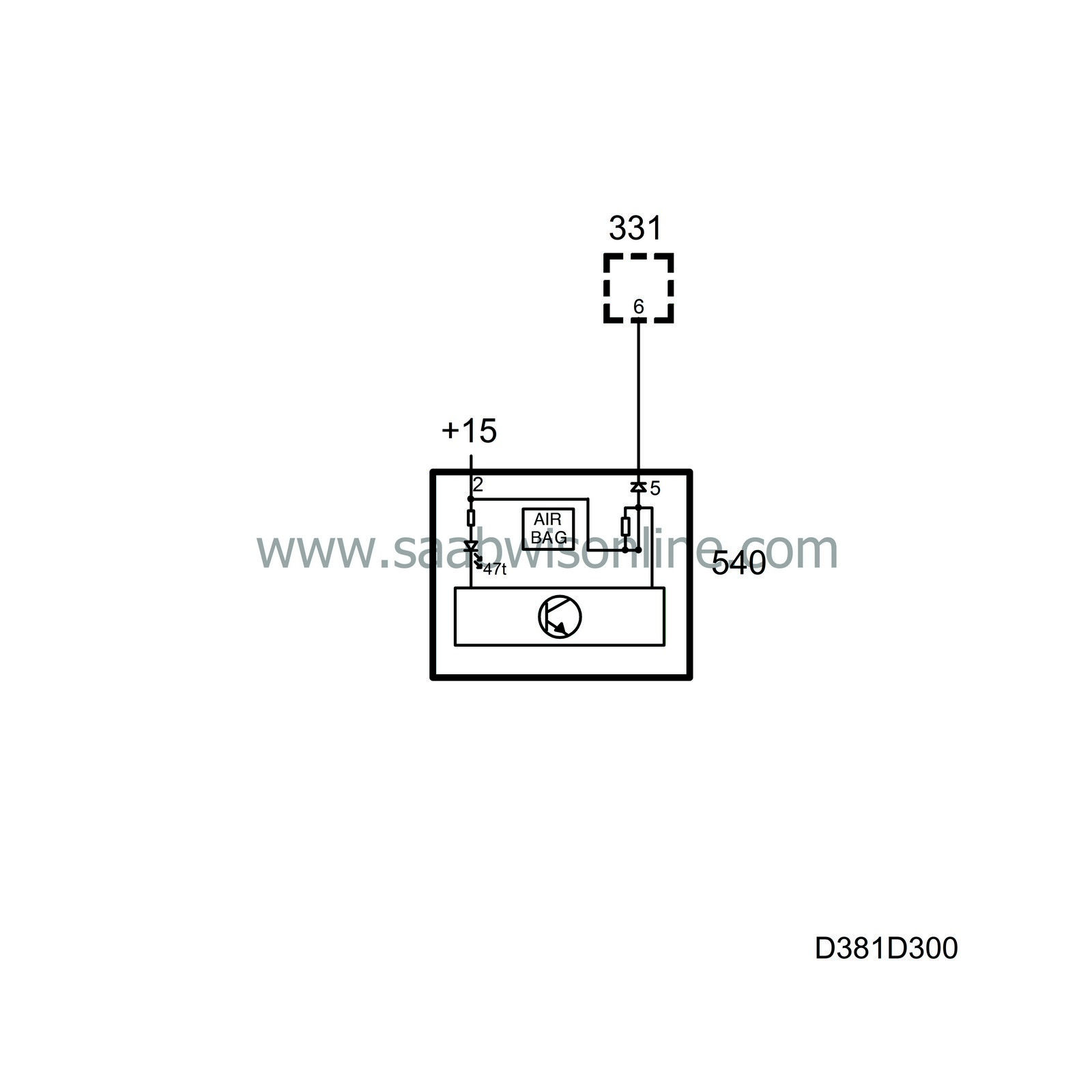
The AIRBAG warning lamp is located in the right-hand part of the main instrument unit. This lamp informs the driver when a fault occurs in the Airbag system. The central warning lamp serves as a second airbag warning lamp and does not go out until all its warning inputs are normal.
The AIRBAG warning lamp is powered with +15 from the main instrument unit and is internally grounded via the main instrument unit.
The AIRBAG warning lamp and the central warning lamp will come on if a fault occurs in the system and at engine speeds above 310 rpm, MIU will send a request to SID to activate the acoustic signal.
If the Airbag system has been activated - sent detonating current to the explosive charges in the gas generators - the AIRBAG Warning lamp and central warning lamp will light up and stay on.
The airbag control module lights the lamp when the ignition is turned on. If there are no faults, the lamp will go out after about 3 seconds.
Diagnostics
An open circuit/short circuit sets a diagnostic trouble code in the Airbag control module.| Warning lamp, brake fluid level |
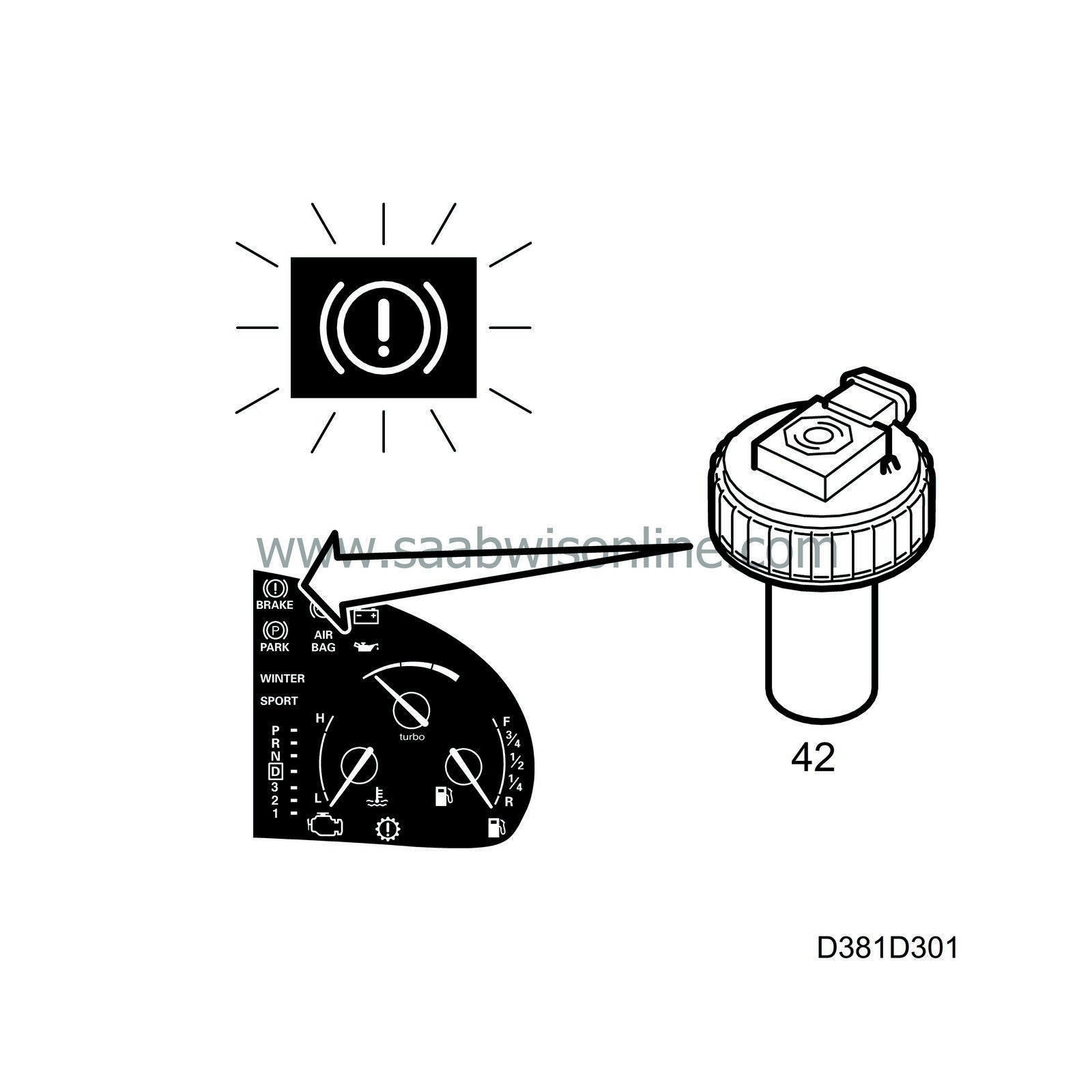
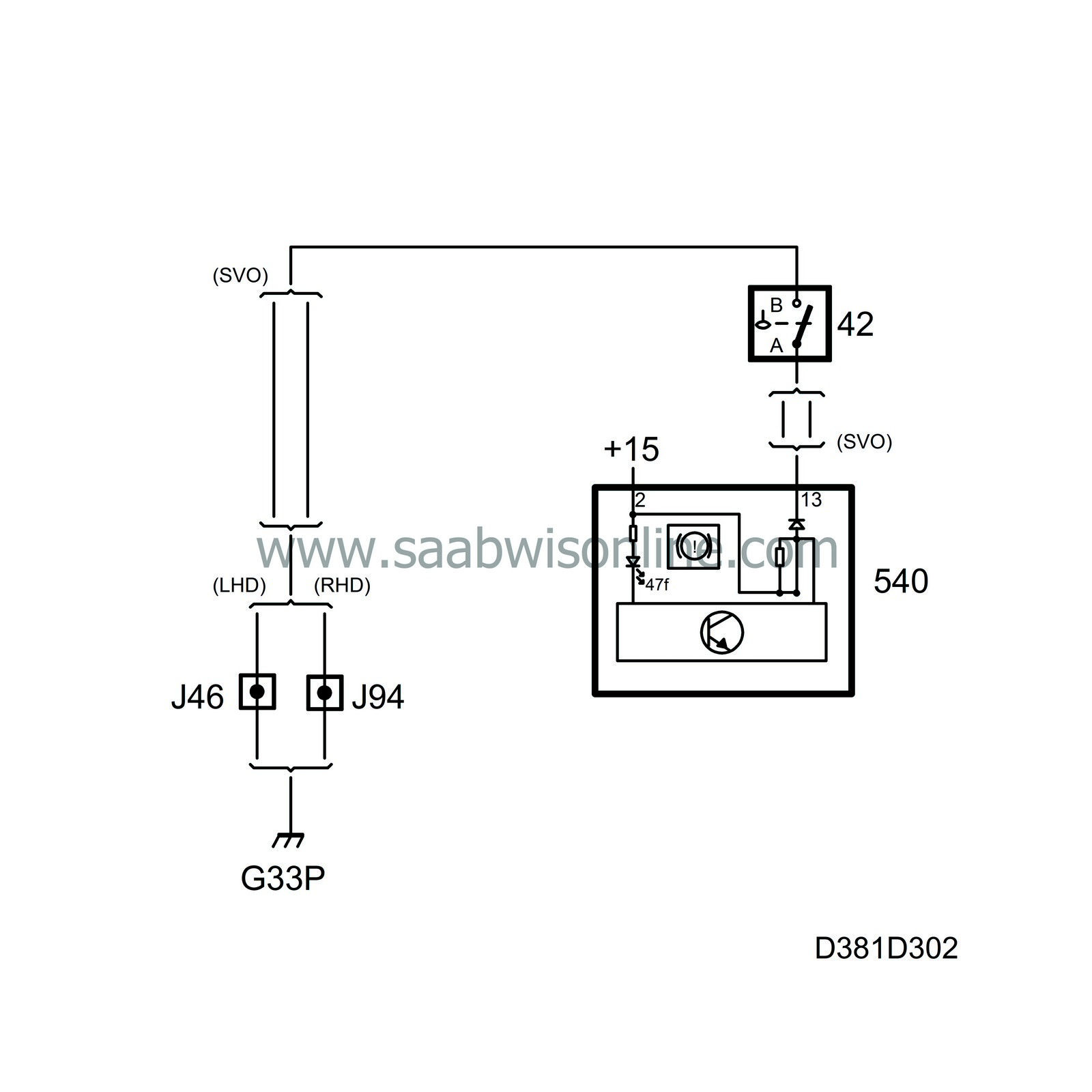
The brake fluid warning lamp tells the driver when the level of the fluid in the reservoir is too low. The lamp also goes on if there is a fault in the ABS system.
If the brake fluid level is too low, the level switch will close and pin 13 on the main instrument unit will be grounded, whereby the control module will turn on the lamp. The central warning lamp will come on at the same time and at engine speeds above 310 rpm, MIU will send a request to SID to activate the acoustic signal.
The main instrument unit lights the brake fluid level warning lamp for 3 seconds when the ignition is turned on.
Diagnostics
The function has no diagnostics.| Warning lamp, handbrake |
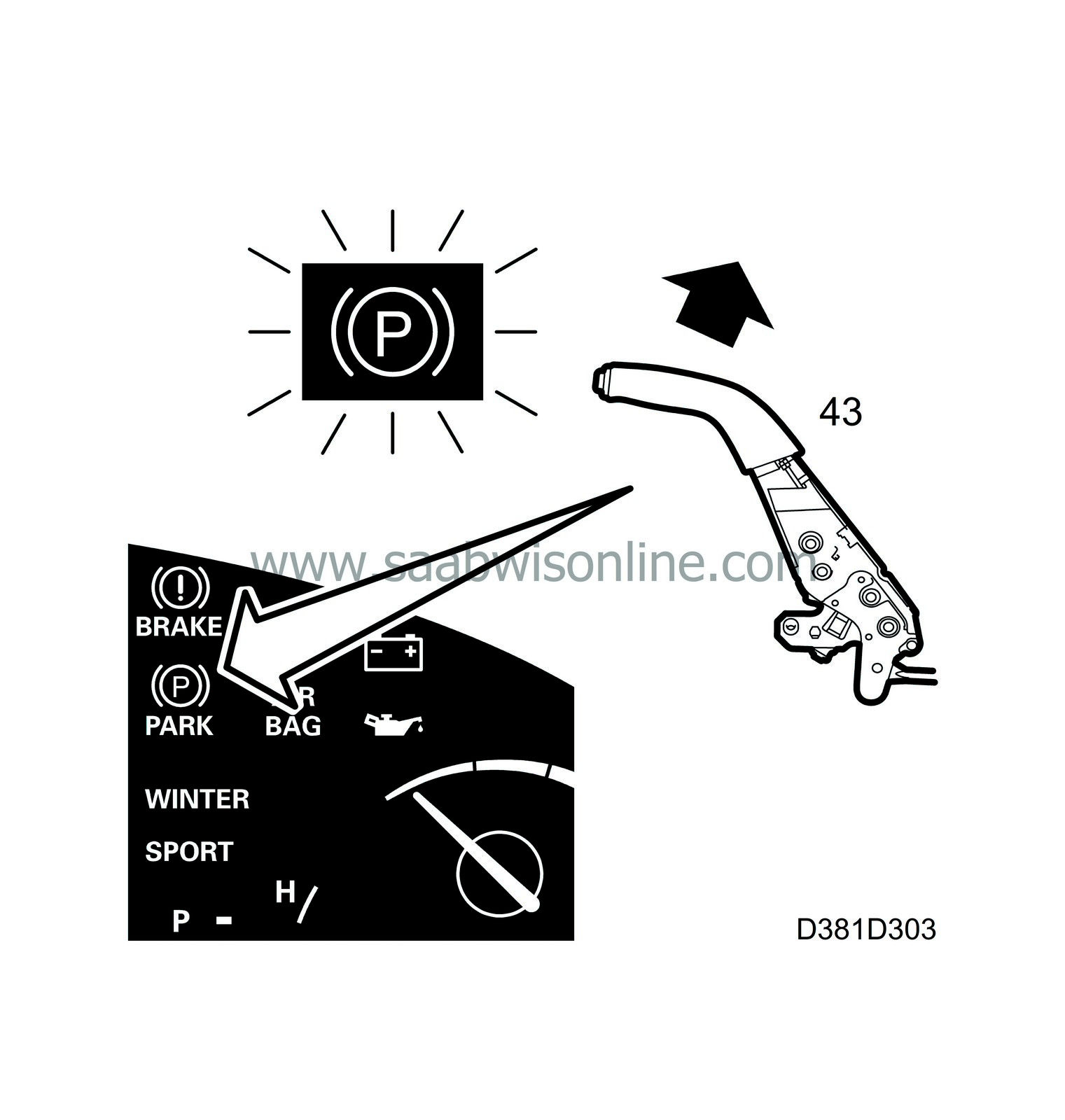
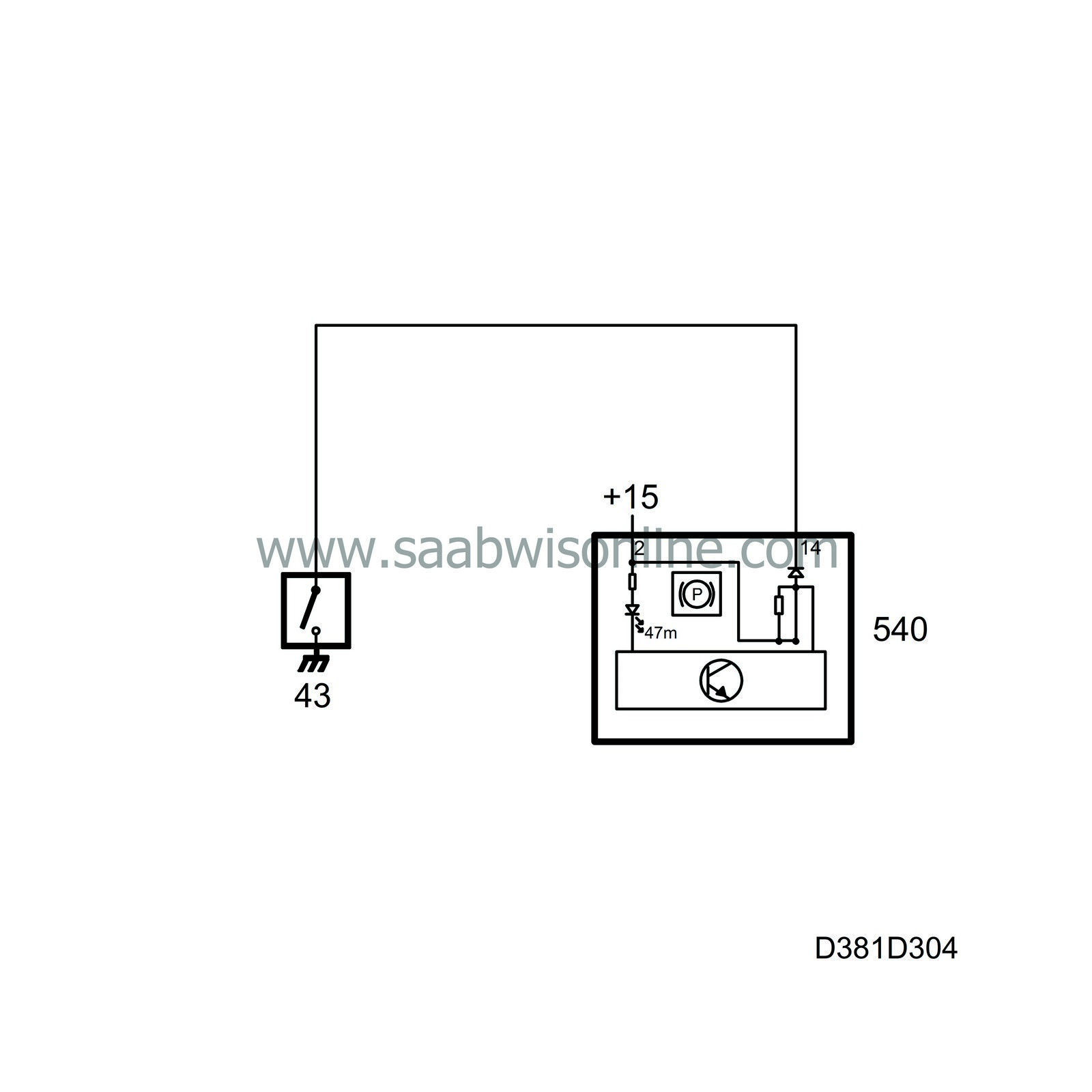
The handbrake warning lamp is situated on the right-hand side of the main instrument unit and informs the driver if the handbrake is applied.
If the oil pressure drops below 0.3-0.5 bar, the oil pressure sensor will close and pin 15 on the main instrument unit will be grounded, whereby the control module will turn on the lamp.
When the handbrake is applied, the switch on the handbrake lever will ground pin 14 on MIU so that the control module will turn on the lamp.
If the road speed passes 5 km/h from a speed below 5 km/h while the handbrake is applied, the central warning lamp will also come on and MIU will send a request to SID to activate an acoustic signal.
Diagnostics
The function has no diagnostics.| TCS indicator lamp |
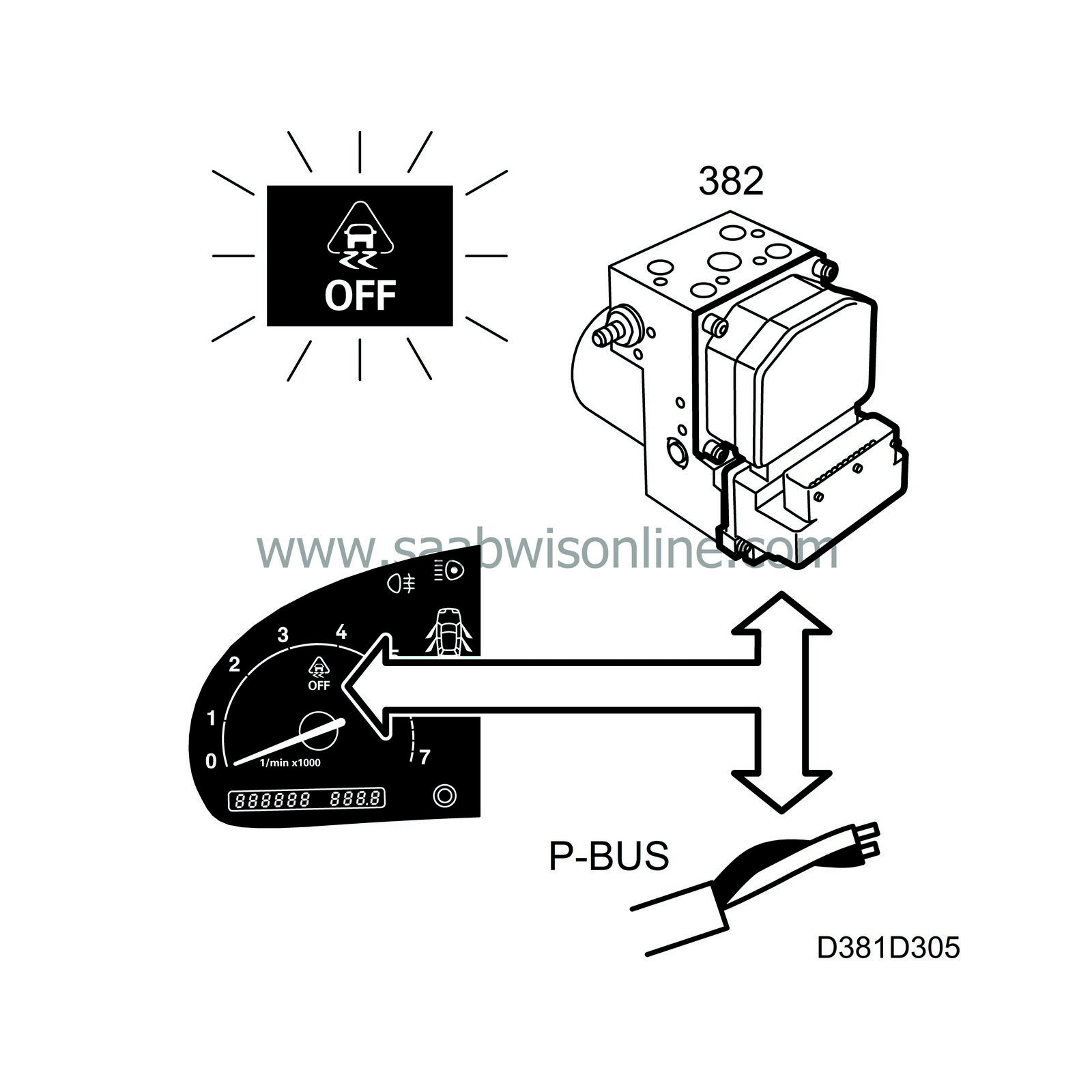

On the left-hand side of the main instrument unit (in the tachometer) is the TCS lamp. The lamp comes on when TCS is active.
The function lamp is turned on after the TC/ABS control module sends information to the P-bus.
The lamp comes on after a short delay (300 ms) when TCS is activated and it stays on as long as the system is in operation or at least for one second. The function lamp comes on for 3-5 seconds when the ignition is turned on.
Diagnostics
The function has no diagnostics.| TCS OFF indicator lamp |

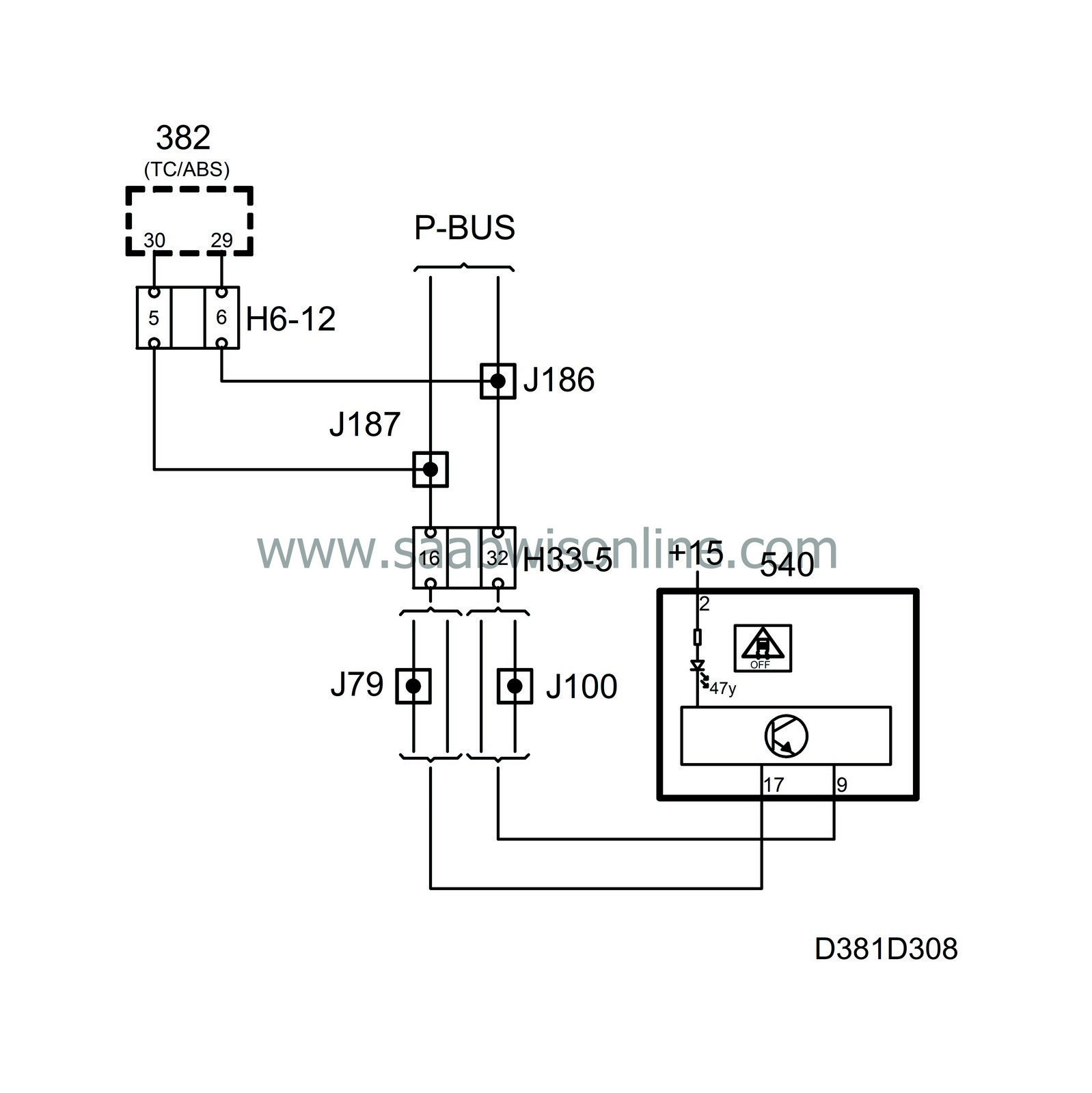
If a fault should occur in the TC/ABS system, the TCS OFF indicator lamp will be turned on via the P-bus. The warning lamp will also come on if the system is disengaged manually, which may be done at speeds below 60 km/h (37.5 mph) by pressing in the TCS switch. The system can be engaged again by pressing the TCS switch at an optional speed, whereby the TCS OFF indicator lamp will go out.
The lamp comes on when the ignition is turned on and will go out again after 3-5 seconds provided there are no faults.
Diagnostics
The ABS, brake fluid and central warning lamps will come on if a fault occurs that affects the ABS function.If there is no bus message from TC/ABS for 2 seconds the TCS OFF and ABS lamps will be turned on. If the bus message is missing for another 8 seconds, the central warning lamp brake fluid warning lamp will also be turned on.
| ABS warning lamp |

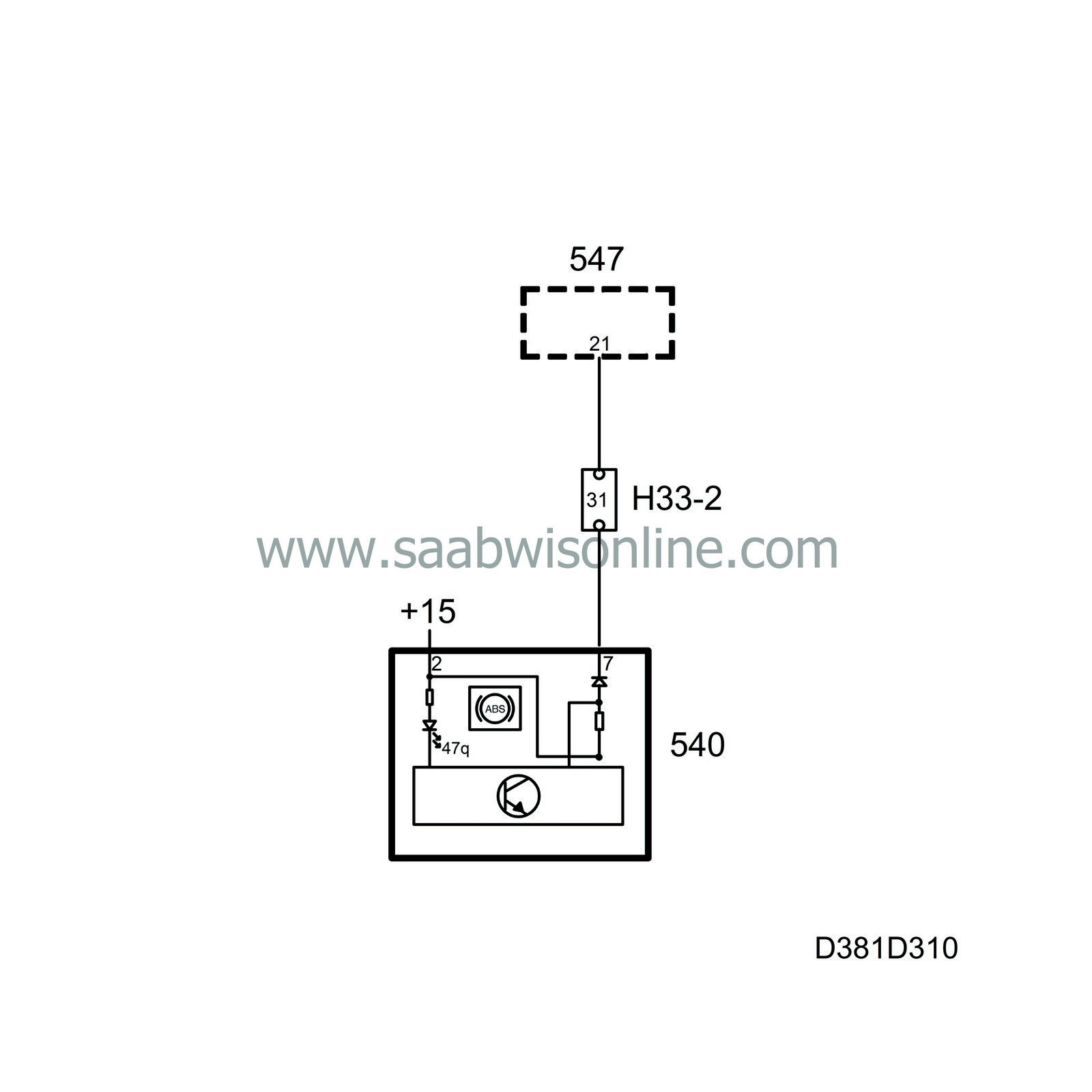
The ABS or TC/ABS control module monitors the function of the ABS system and turns on the ABS warning lamp on the right-hand side of the main instrument unit if there is a problem.
When the ABS lamp lights up, the anti-lock braking system is disabled and the brakes work just like a conventional braking system.
On cars with ABS (non-bus system), the ABS control module will ground pin 7 on the main instrument unit, whereby the control module will turn on the warning lamp.
On cars with TC/ABS (bus system) , the main instrument unit will receive information on the bus to turn on/off the lamp.
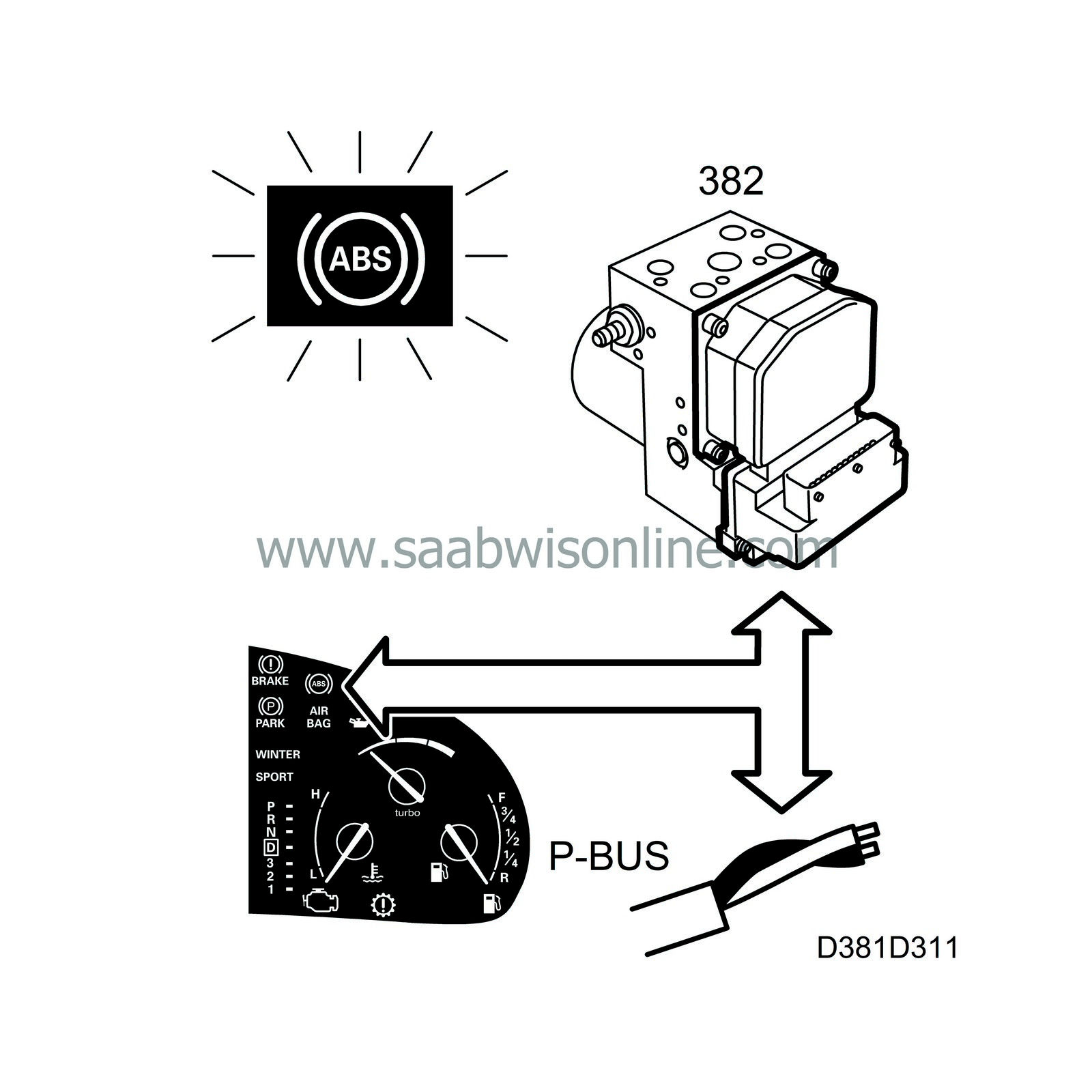
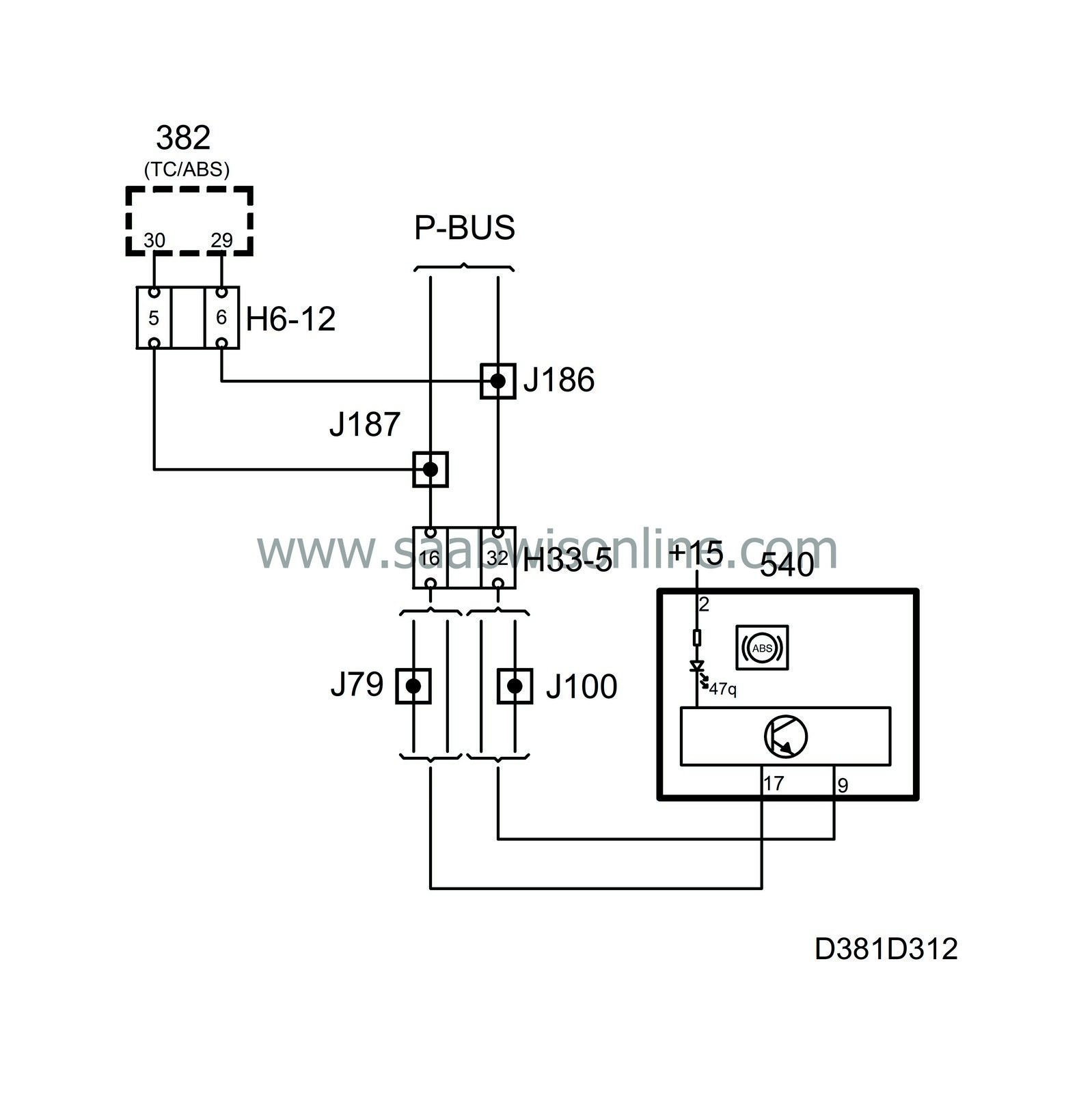
The TC/ABS control module turns on the lamp when the ignition is turned on and turns it off again after about 3 seconds provided there are no faults.
The brake fluid warning lamp and the central warning lamp will also come on when the ABS warning lamp comes on.
Diagnostics
The function has no diagnostics.| SPORT indicator lamp |
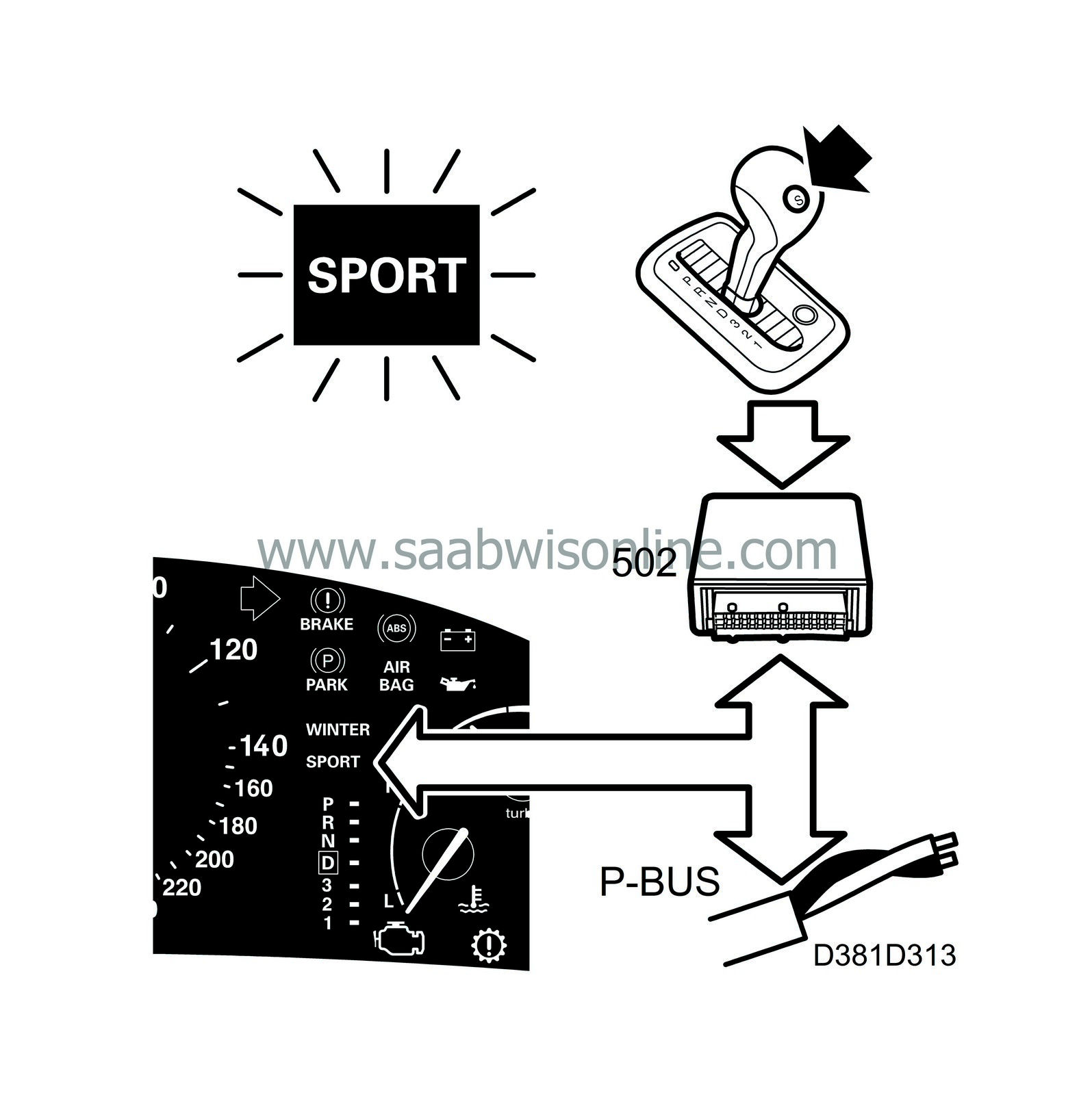
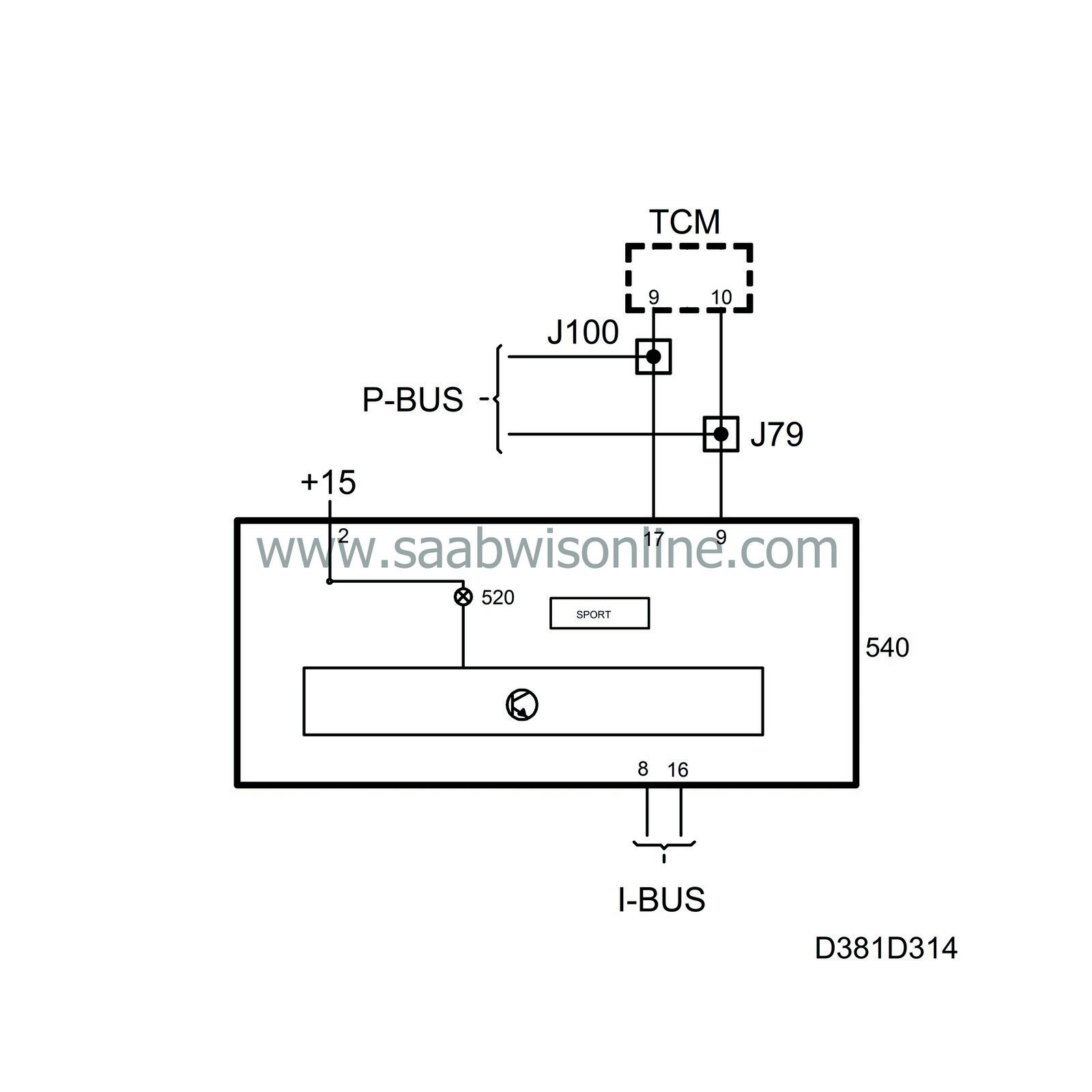
On cars with automatic transmission, the SPORT indicator lamp will come on when the Sport button (S) on the selector lever is pushed in. The sport function can be activated in positions D, 3, 2 and 1.
In SPORT mode, the transmission remains longer in each gear.
The lamp is powered by the main instrument unit and is grounded by the main instrument unit control module. TCM sends continuous bus information SPORT, unit ON/OFF.
The indicator lamp goes out under the following conditions:
| • |
When the sport button is depressed again.
|
|
| • |
When the transmission is in Limp-home mode.
|
|
| • |
When Winter mode is selected.
|
|
| • |
If the ignition is turned off and then on again.
|
|
| • |
Selector lever to P or R.
|
|
Diagnostics
The function has no diagnostics.| WINTER indicator lamp |
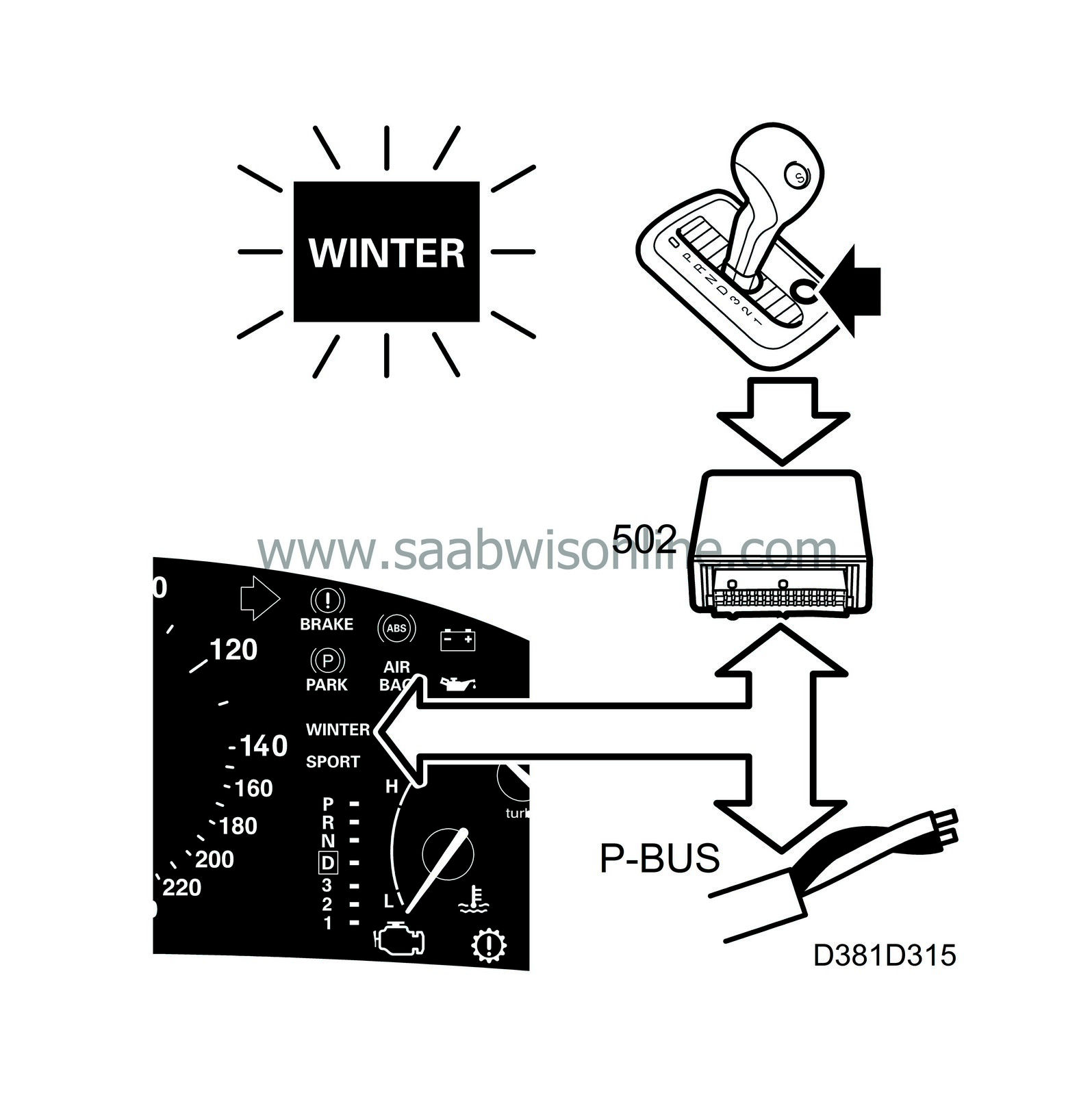
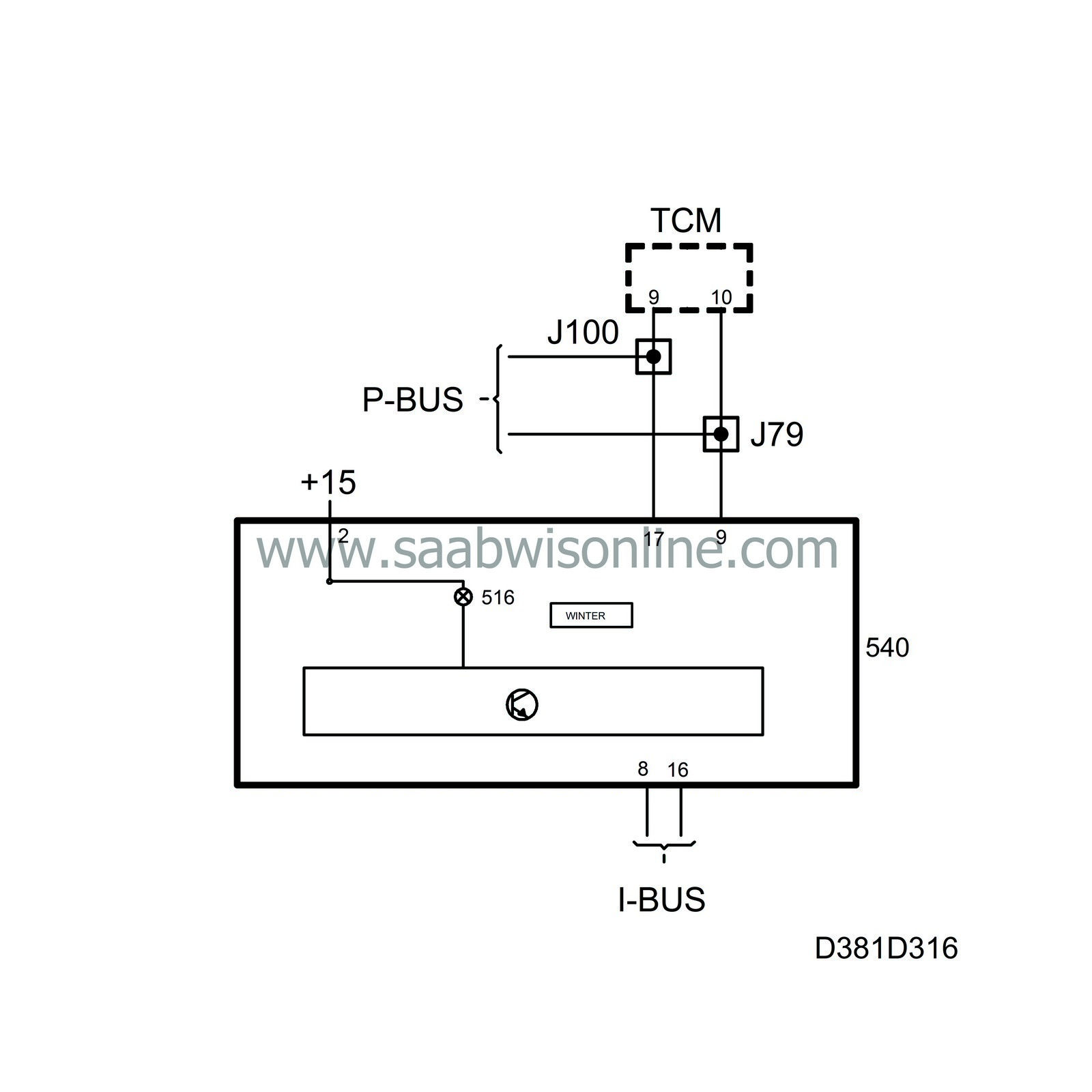
To facilitate moving off on slippery road surfaces, the TCM has a winter mode, i.e. the car starts in 3rd gear when the Winter button (W) beside the selector lever is depressed.
The lamp is powered by the main instrument unit and is grounded internally by the main instrument unit. TCM sends continuous bus information WINTER ON, unit ON/OFF.
When WINTER ON is active, the control module will ground the output for the lamp, which then comes on.
The indicator lamp goes out under the following conditions:
| • |
When the Winter button is pressed again.
|
|
| • |
When the transmission is in Limp-home mode.
|
|
| • |
If the ignition is turned off and then on again.
|
|
| • |
When the transmission fluid temperature is above 140°C.
|
|
Diagnostics
The function has no diagnostics.| CHECK GEARBOX indicator lamp |
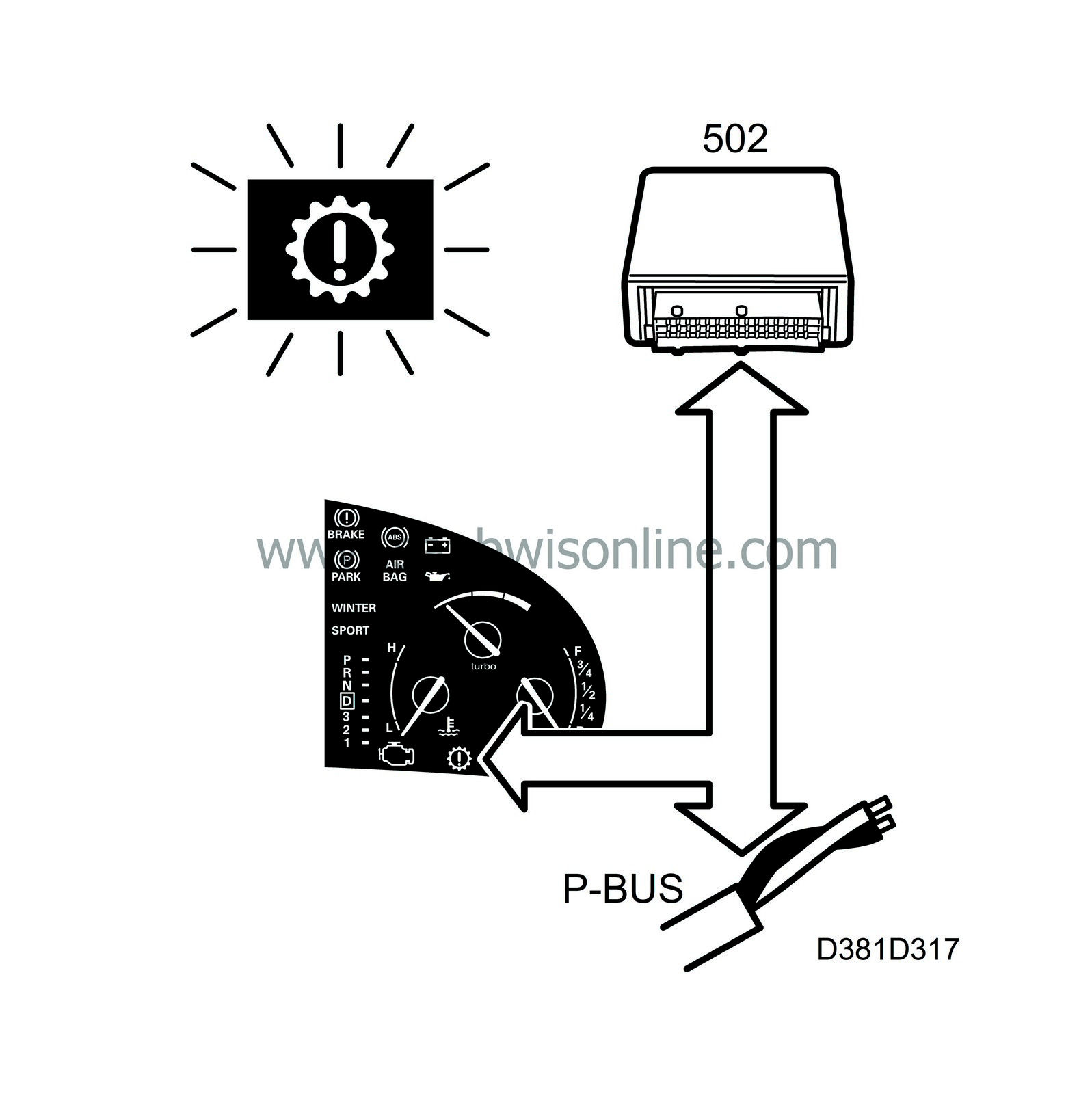
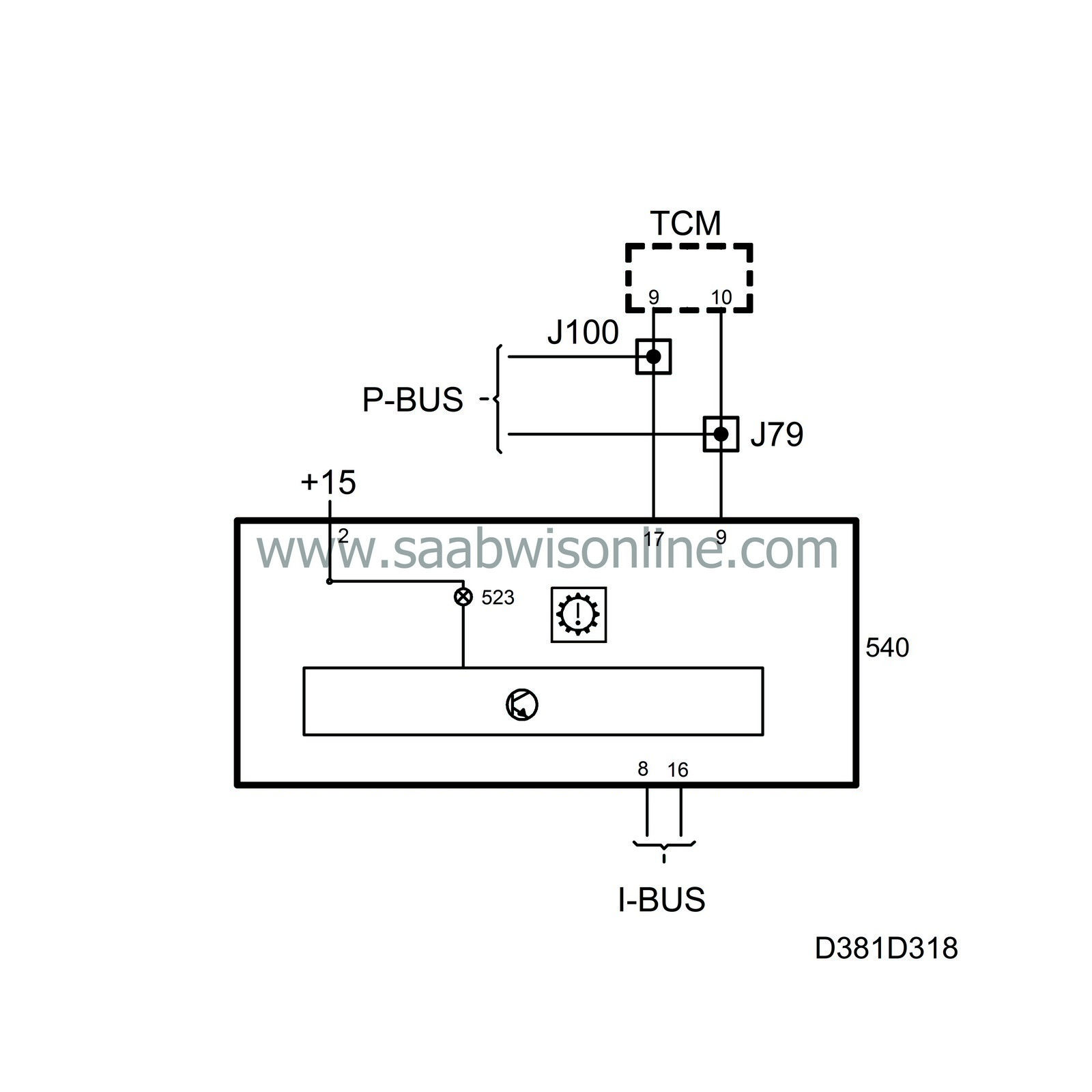
If there is a fault in the automatic transmission or its control module, the TCM lights the CHECK GEARBOX warning lamp in the main instrument unit.
The lamp is powered by the main instrument unit and is grounded internally by the main instrument unit. TCM sends continuous bus information CHECK GEARBOX, unit ON/OFF.
When CHECK GEARBOX is active, the control unit will ground the output for the lamp, which then comes on.
The lamp will go out when TCM sends the message CHECK GEARBOX OFF.
When the ignition is turned on, the TCM lights the lamp for approx. 3 seconds and if there is no fault the lamp will go out.
Diagnostics
The function has its own diagnostics in the sending system.| Fuel reserve indicator lamp |
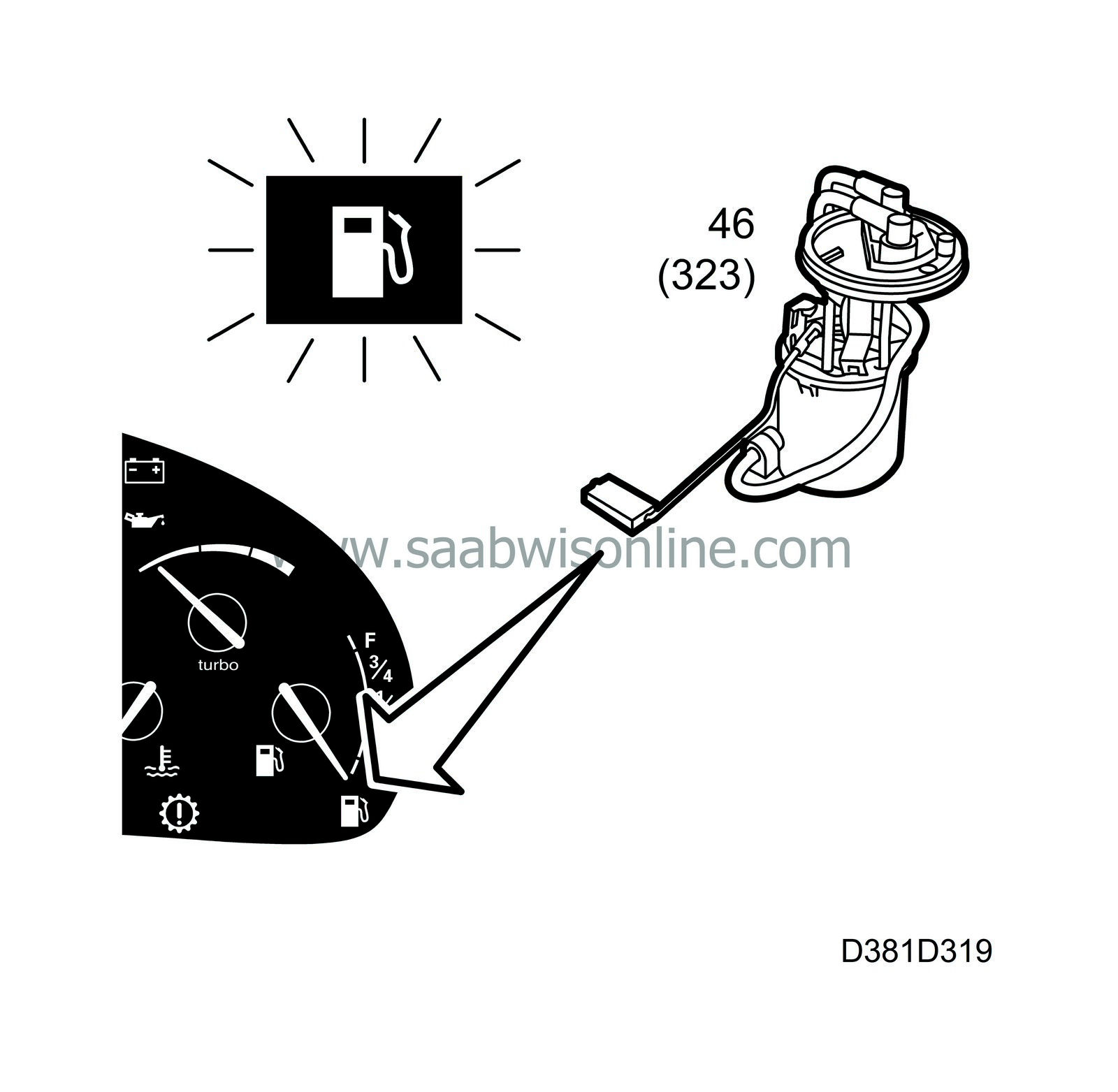
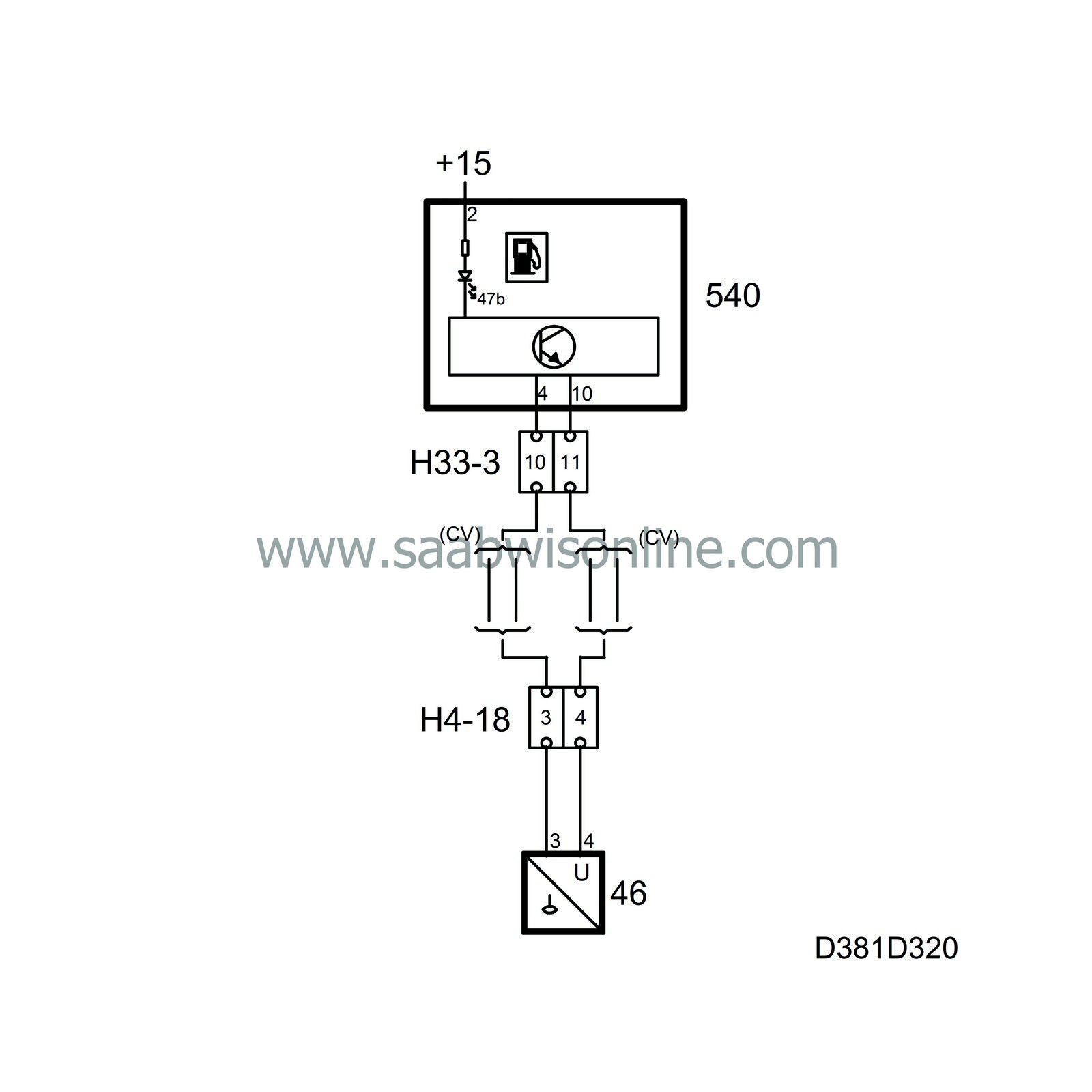
When there is about 10 litres of fuel left, a lamp will come on to indicate low fuel level. The lamp is powered by the main instrument unit and is grounded internally by the main instrument unit to turn it on.
The main instrument unit lights the lamp for 3 seconds when the ignition is switched on.
Diagnostics
An open circuit/short circuit sets diagnostic trouble code B1720. The gauge needle indicates 0 litres and the fuel reserve indicator lamp lights up.| Glow indicator lamp |
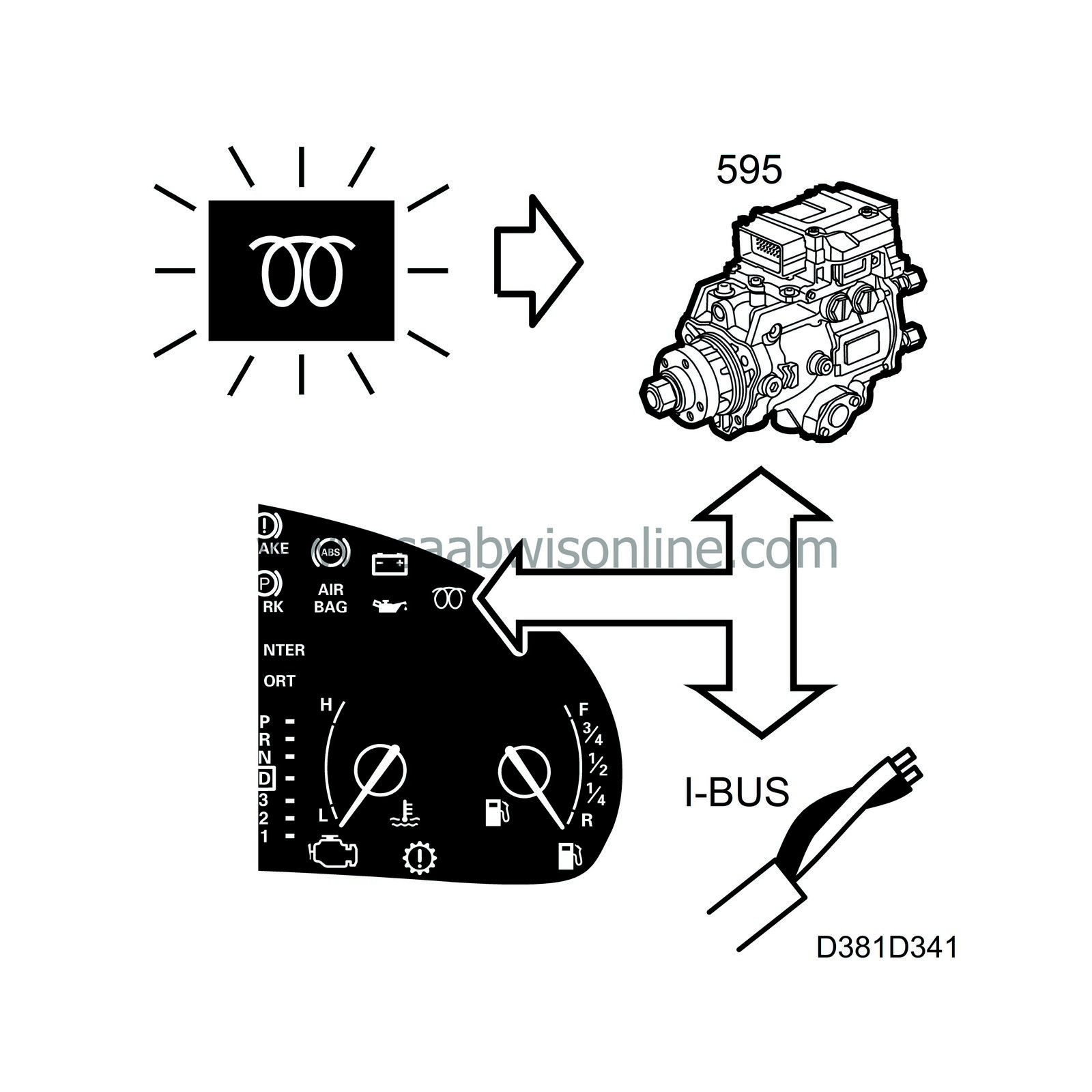

The glow indicator lamp goes on during pre-heating.
The lamp is powered by the main instrument unit and is grounded by the main instrument unit control module. PSG 16 sends continuous bus information Pre-heating, unit ON/OFF.
When pre-heating is ON, the control module will ground the lamp output so that it goes on.
Diagnostics
The function has its diagnostics in the sending system.| CHECK ENGINE indicator lamp |
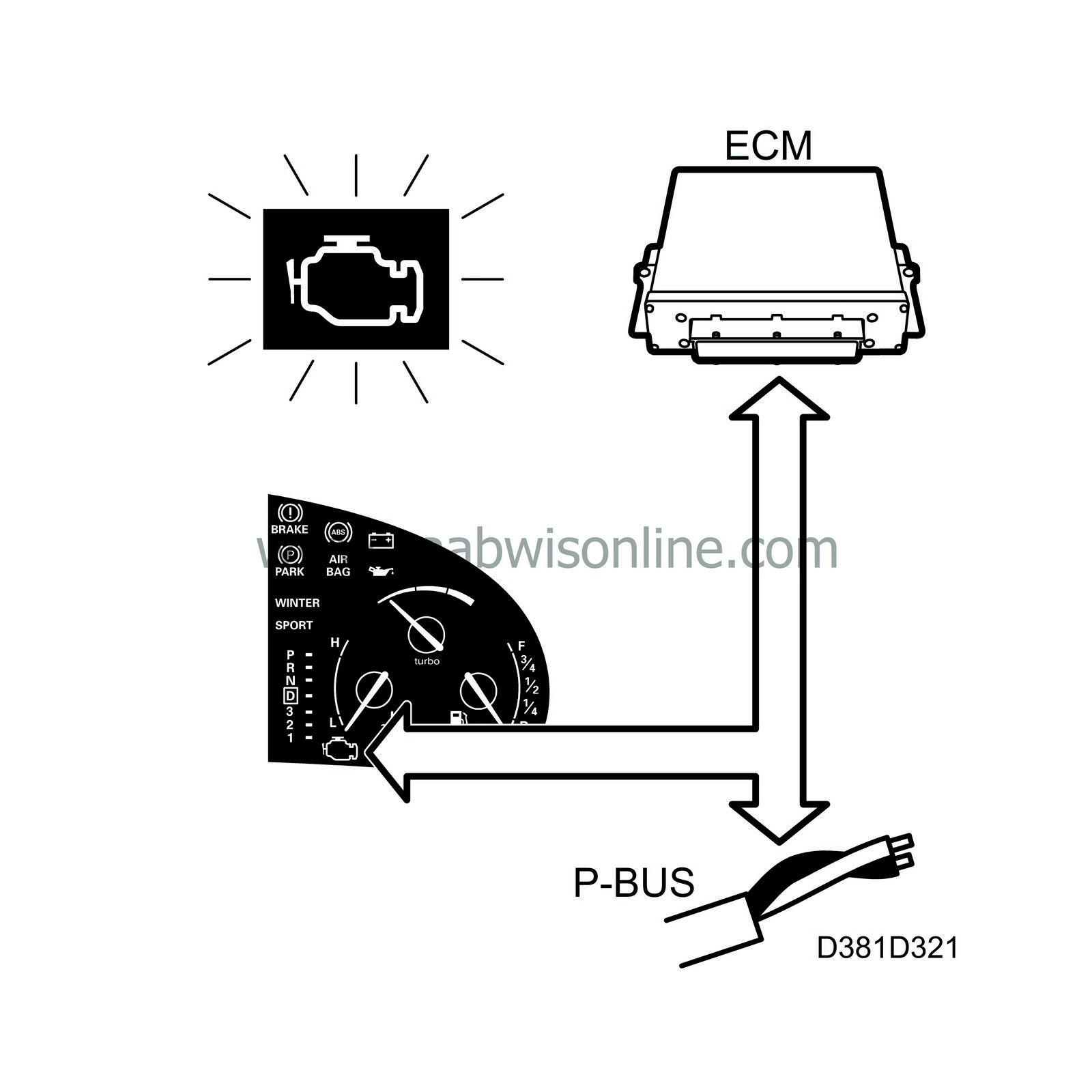
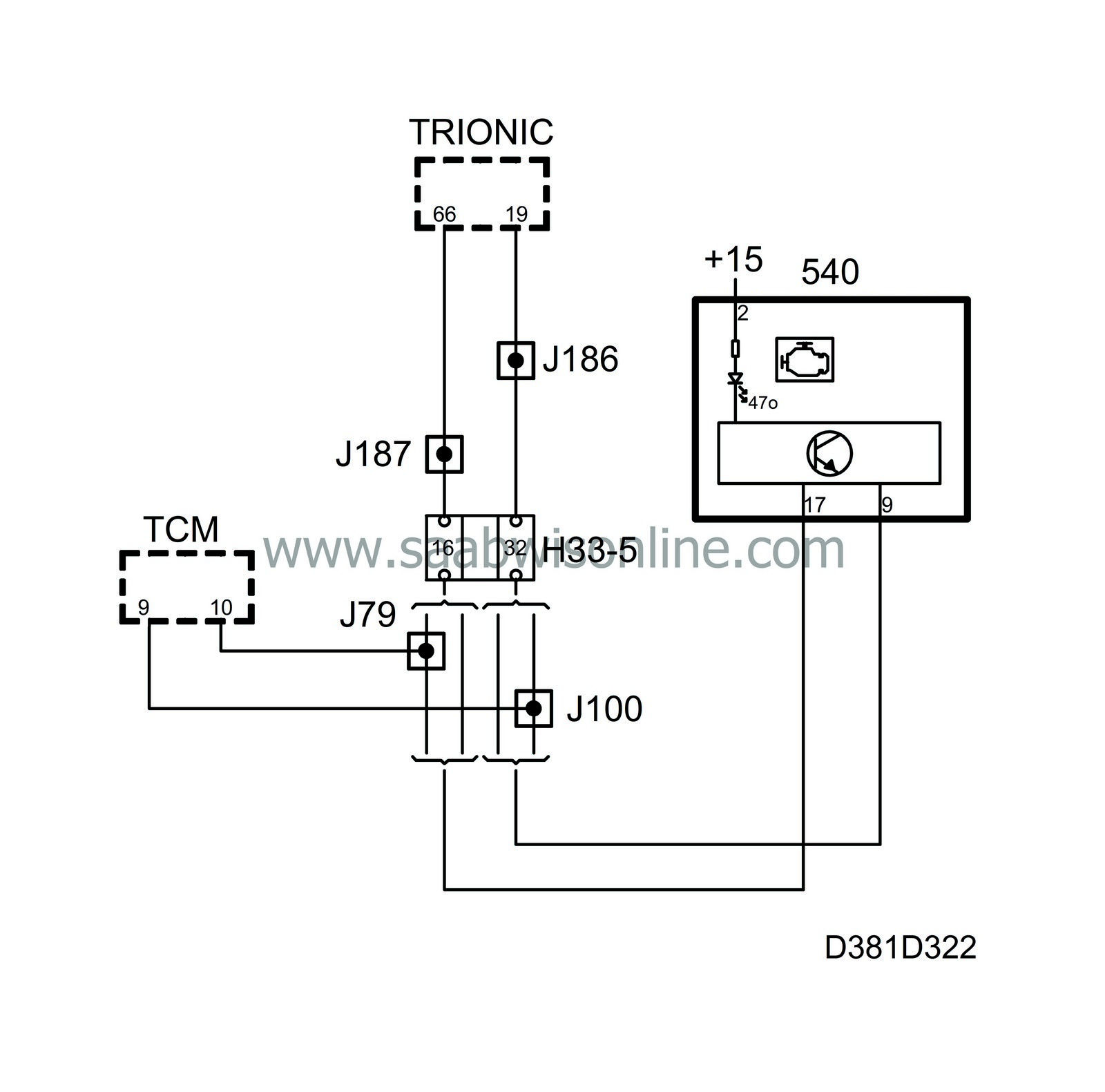
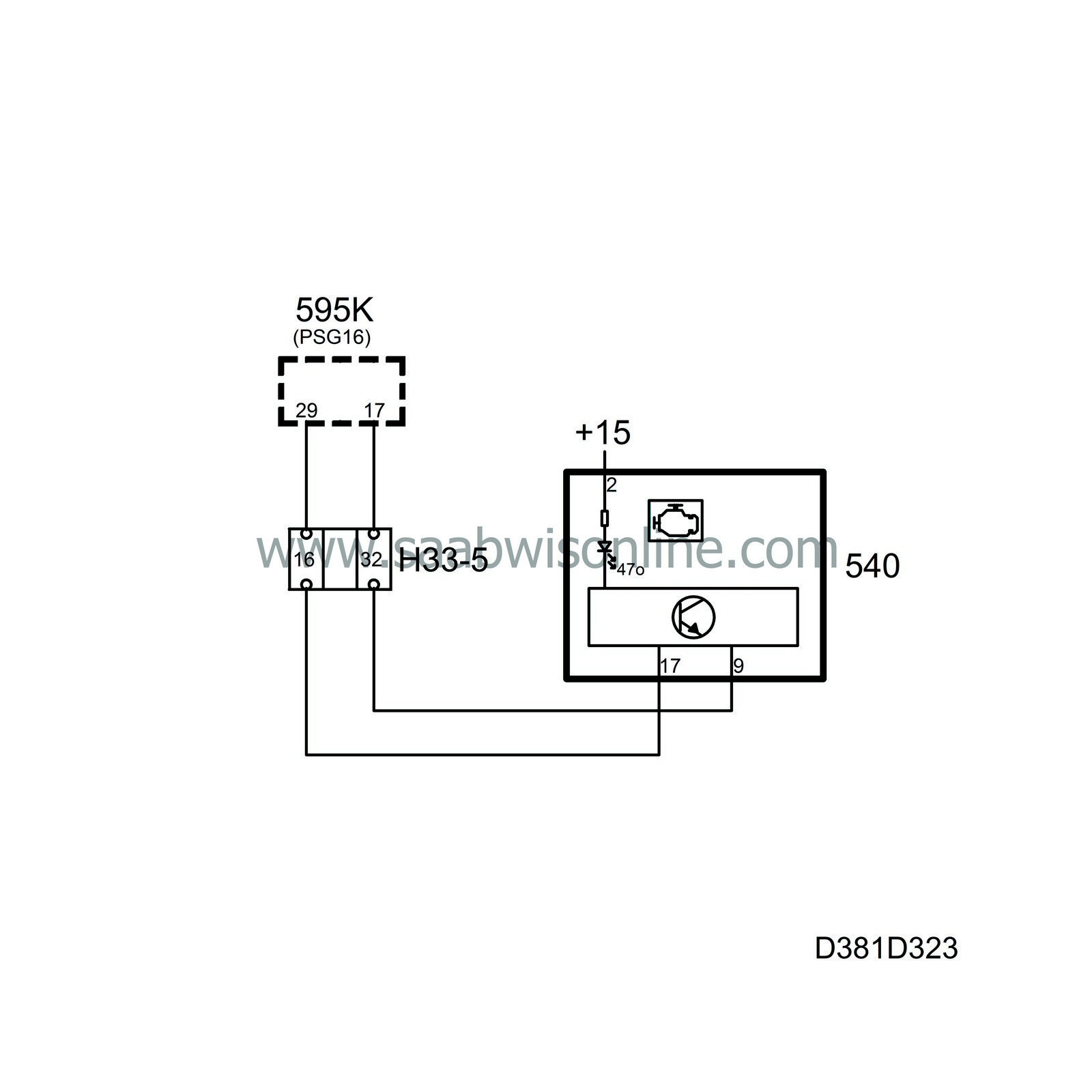
The CHECK ENGINE lamp (MIL) warns the driver when a fault occurs in the engine management system.
The lamp is powered by the main instrument unit and is grounded internally by the main instrument unit. The engine control module sends continuous bus information CHECK ENGINE, unit ON/OFF.
On receiving CHECK ENGINE ON, the control module grounds the output of the lamp, which then lights up.
On certain markets, TCM (Transmission Control Module) will turn on the CHECK ENGINE lamp.
If the engine control module changes the status of the message to CHECK ENGINE OFF, the lamp will go out.
The lamp will stay on until the engine is started if the ignition is turned to ON. Provided there are no faults, the engine control module will send bus information CHECK ENGINE OFF and the lamp will go out.
Diagnostics
The function has no diagnostics.| Direction indicator repeater lamps RH and LH |
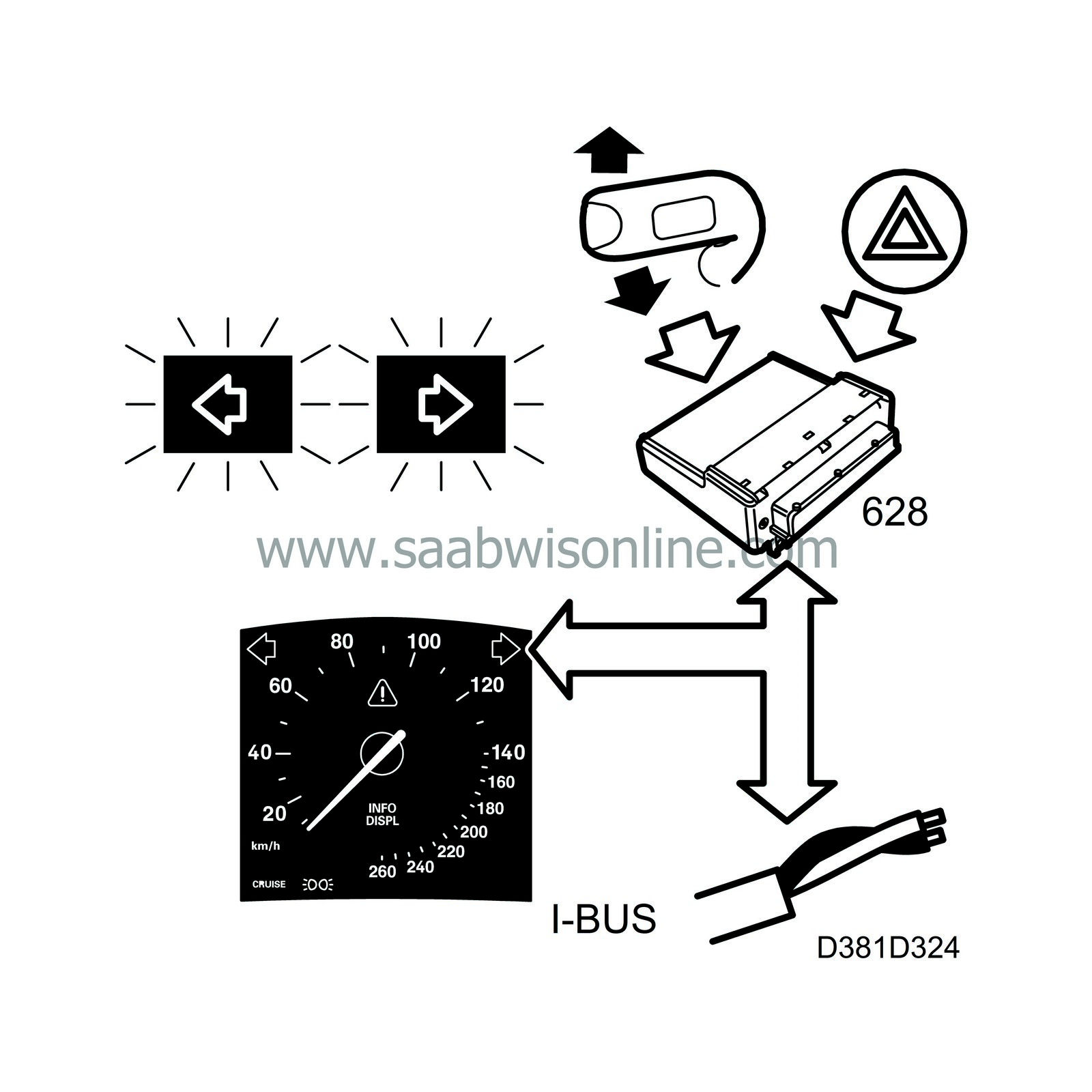
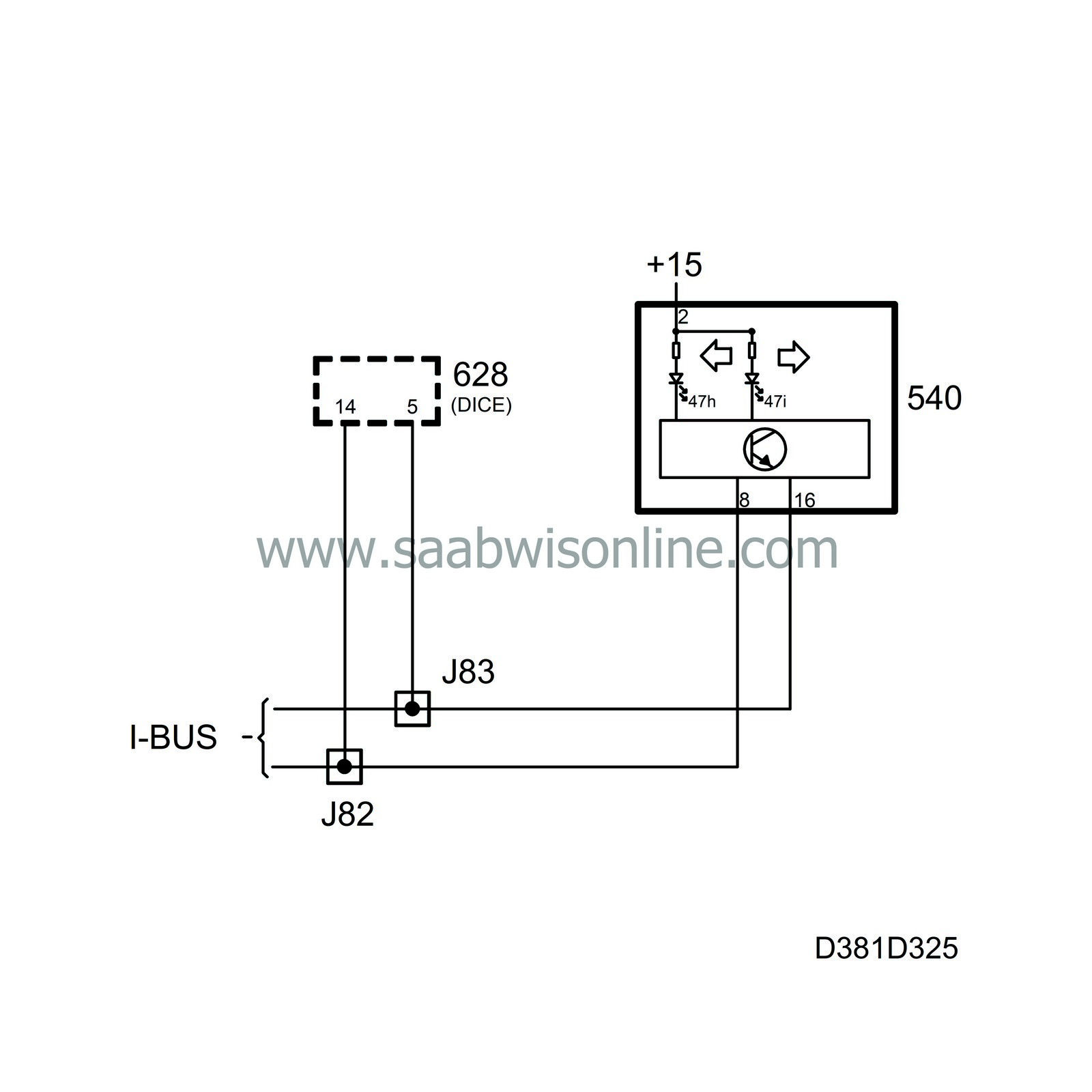
The repeater lamps are situated in the upper part of the main instrument unit and show when the direction indicators are on.
The lamps are powered by the main instrument unit and are grounded internally by the main instrument unit. DICE sends continuous bus information on the status of DIRECTION INDICATORS RIGHT and DIRECTION INDICATORS LEFT, unit ON/OFF.
On receiving DIRECTION INDICATORS ON, the control module grounds the output of the lamp in question which then lights up.
Example
If the LH direction indicators are activated, DICE will change the status of the information DIRECTION INDICATORS LEFT ON/OFF at the same time as the direction indicator lamps are lit. In this way, the main instrument unit control module can synchronize the flashing of the repeater lamps with the direction indicator lamps.The SID also activates the TIC-TAC sound at the same time as the lamps flash.
The function is the same for the RH direction indicators.
| Hazard flashers |
The hazard flashers function is the same as for direction indicators Left/Right except that both lamps are activated at the same time.
When the hazard flashers are activated and the ignition is OFF, the indicator lamps will not flash.
Diagnostics
The function has no diagnostics.| Cruise indicator lamp |
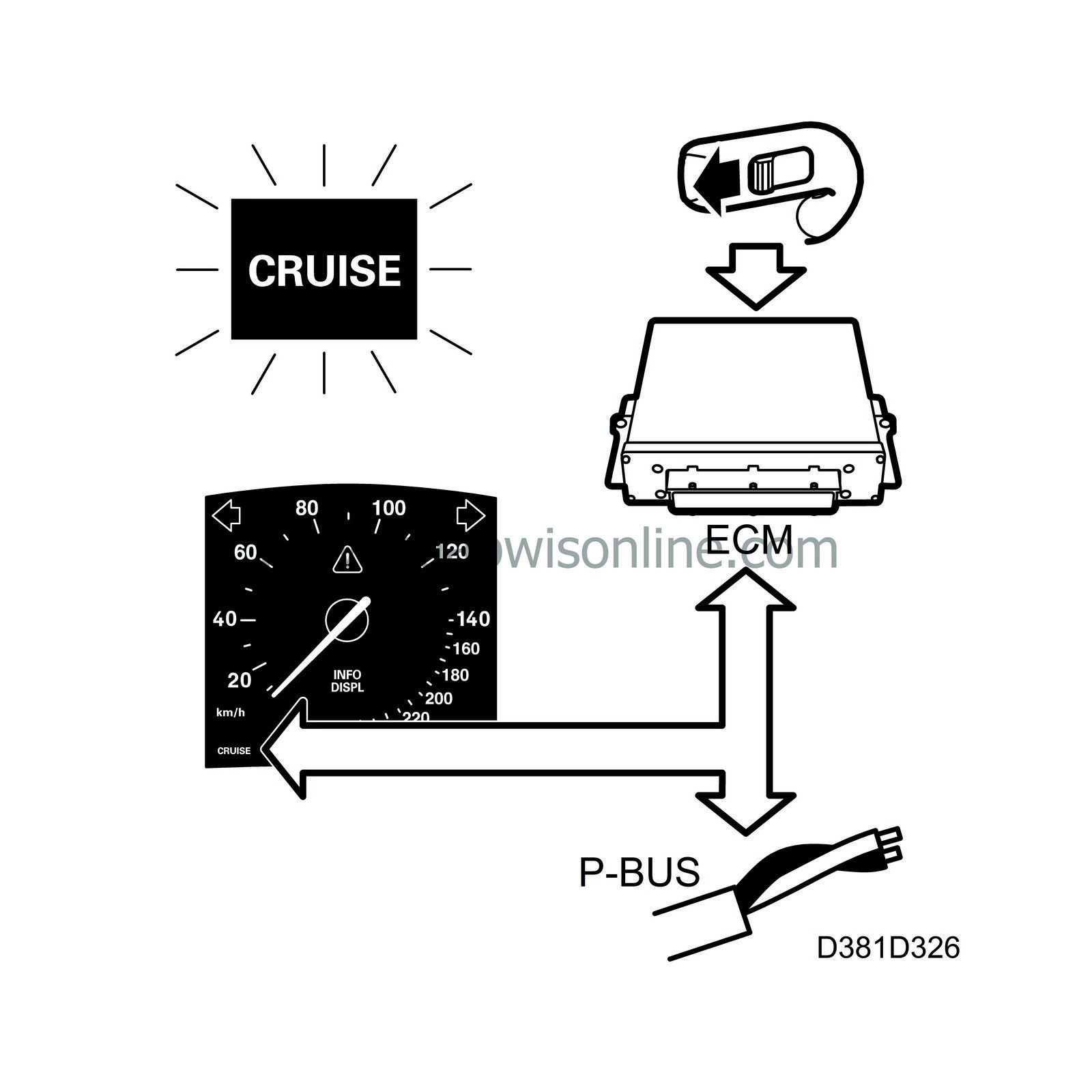

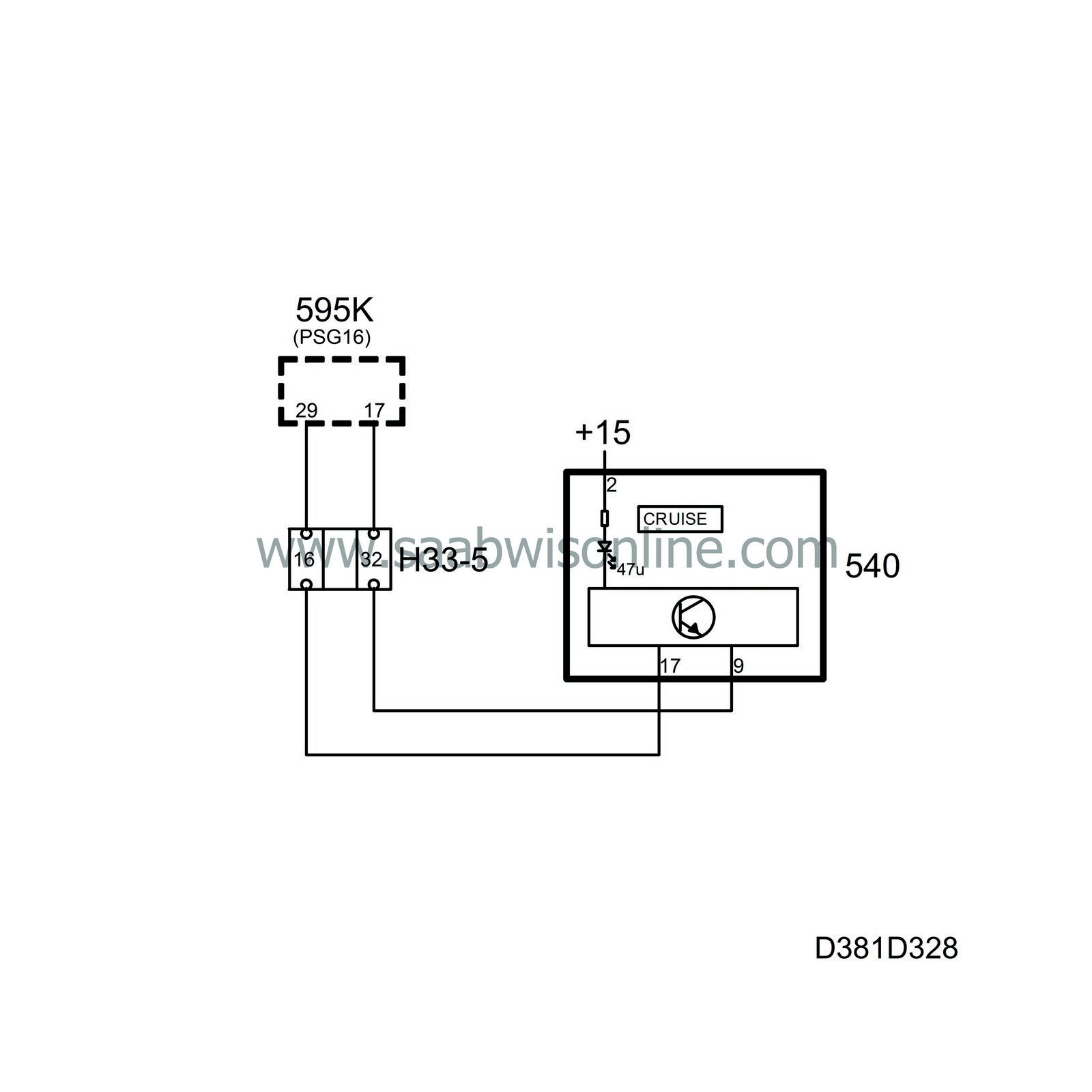
The main instrument unit incorporates a CRUISE indicator lamp that lights up when Cruise Control is engaged.
The lamp is powered by the main instrument unit and is grounded internally by the main instrument unit. The engine control module sends continuous bus information CRUISE Lamp, unit ON/OFF.
On receiving CRUISE Lamp ON, the control module grounds the output of the lamp which then lights up.
After disengaging cruise control, the engine control module will change the status of the information to CRUISE Lamp OFF and the lamp will go out.
Diagnostics
The function has its own diagnostics in the sending system.| SHIFT UP indicator lamp |
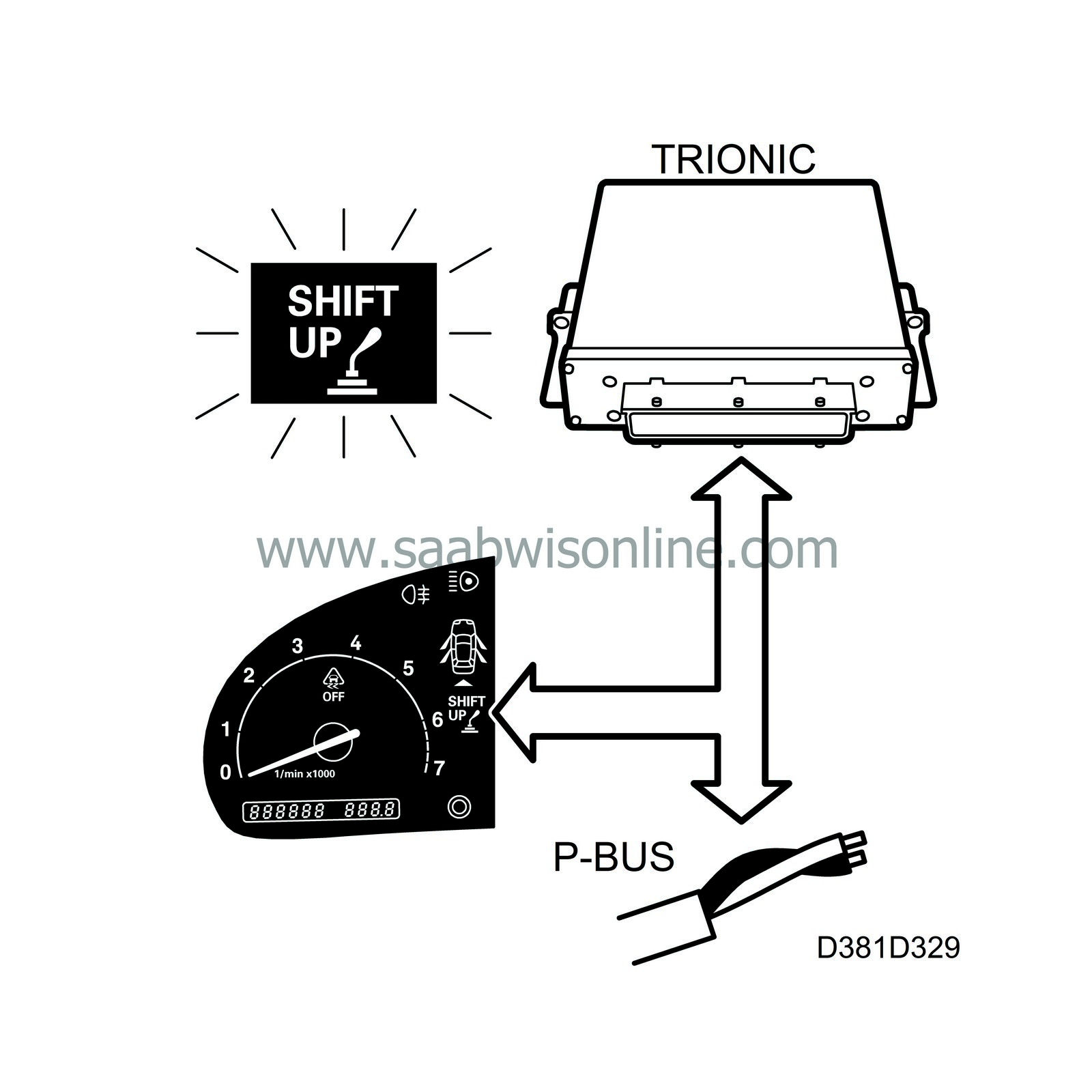
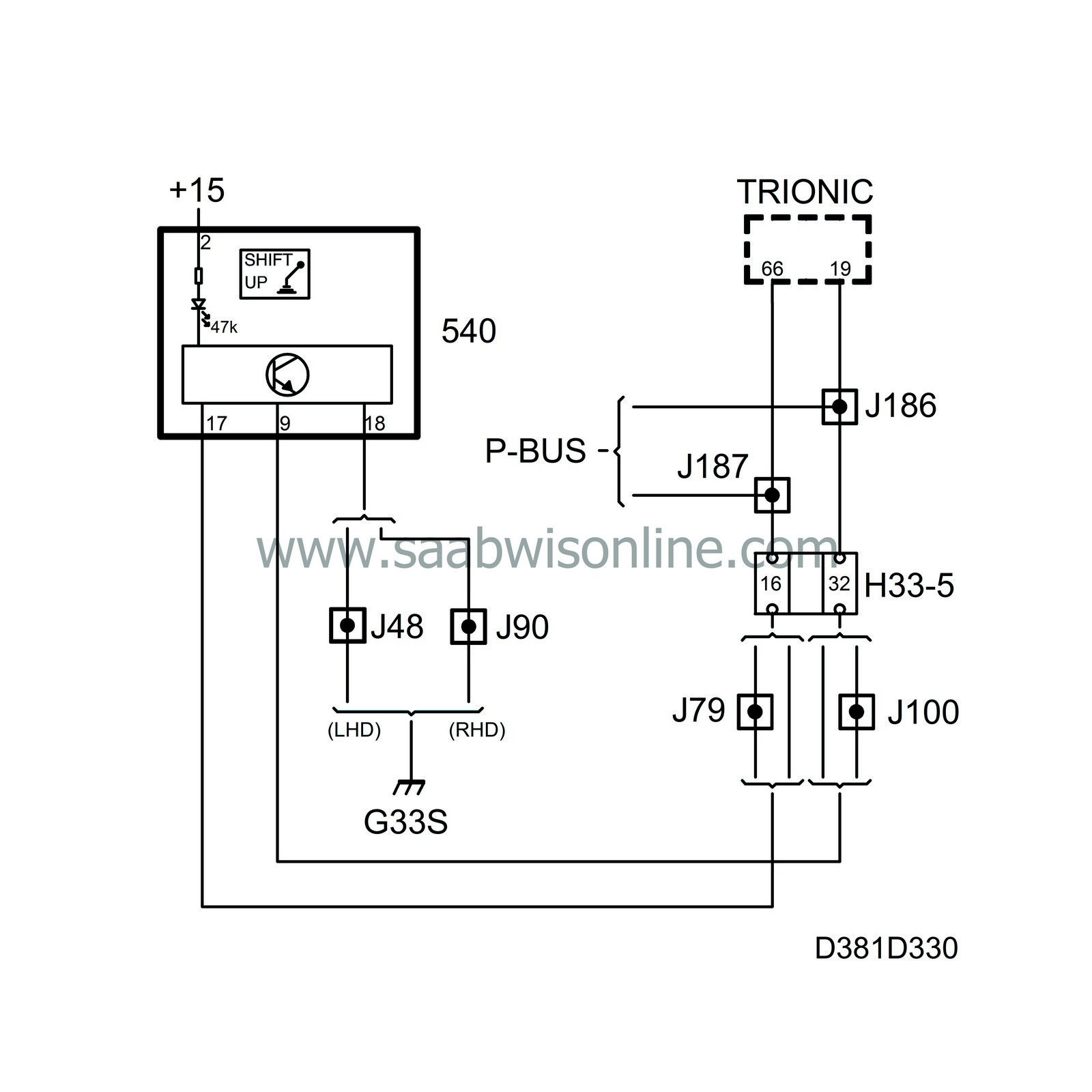
To achieve low fuel consumption, the SHIFT UP indicator lamp in the main instrument unit comes on when a higher gear should be engaged (certain markets).
The lamp is powered by the main instrument unit and is grounded internally by the main instrument unit. The engine control module sends continuous bus information SHIFT-UP, unit ON/OFF.
On receiving SHIFT-UP ON, the control module grounds the output for the lamp which then lights up.
If a higher gear is engaged, the engine control module will change the status of the information to SHIFT-UP OFF and the lamp will go out.
Diagnostics
The function has its own diagnostics in the sending system.| Lights-on indicator lamp |

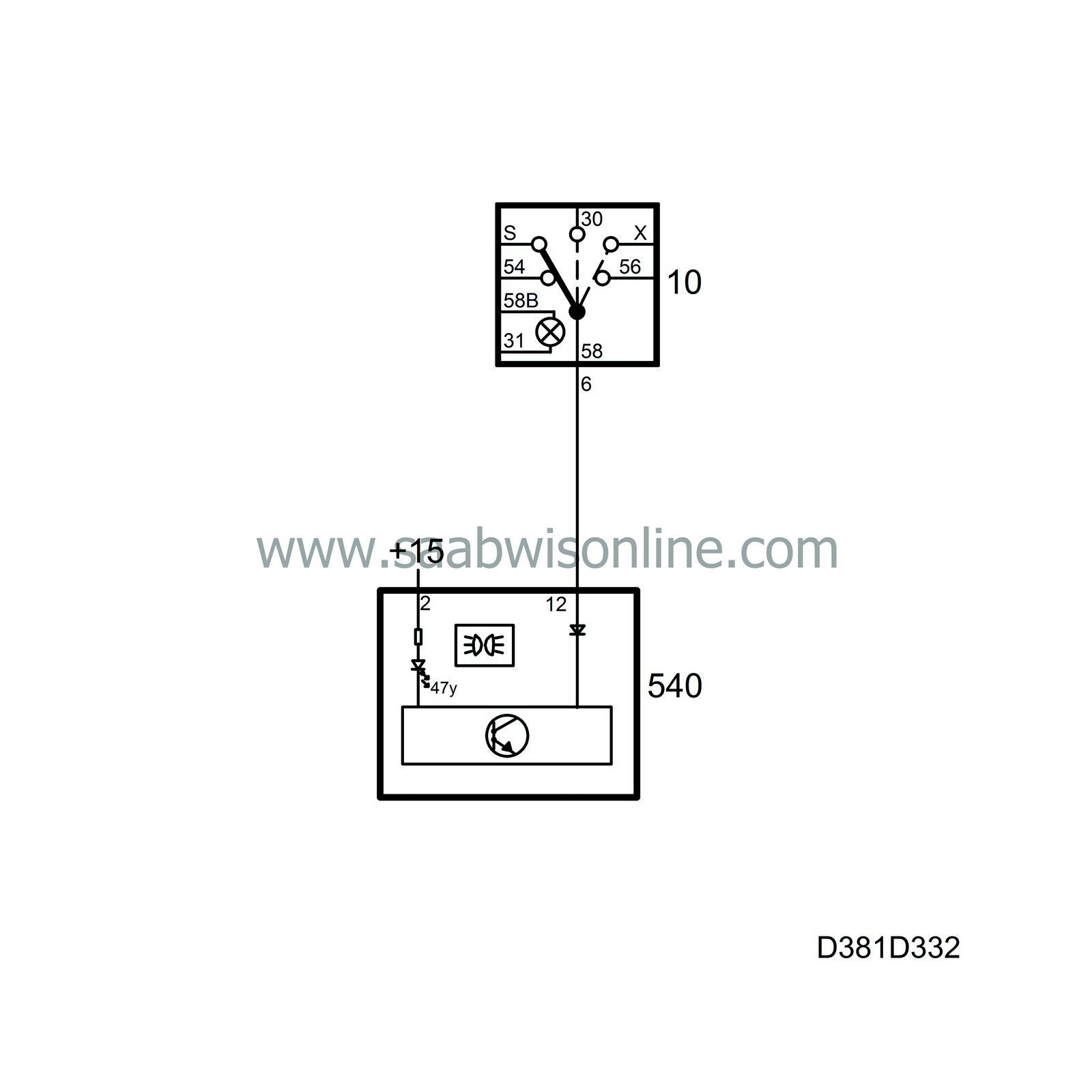
An indicator lamp shows when the headlamps are switched on. The lamp is situated below the speedometer.
The lamp is powered by the main instrument unit and is grounded internally by the main instrument unit. The indicator lamp is turned on by the control module when the main instrument unit input (pin 12) is supplied with B+ from the light switch.
Diagnostics
The function has no diagnostics.| Indicator lamp, rear fog light |
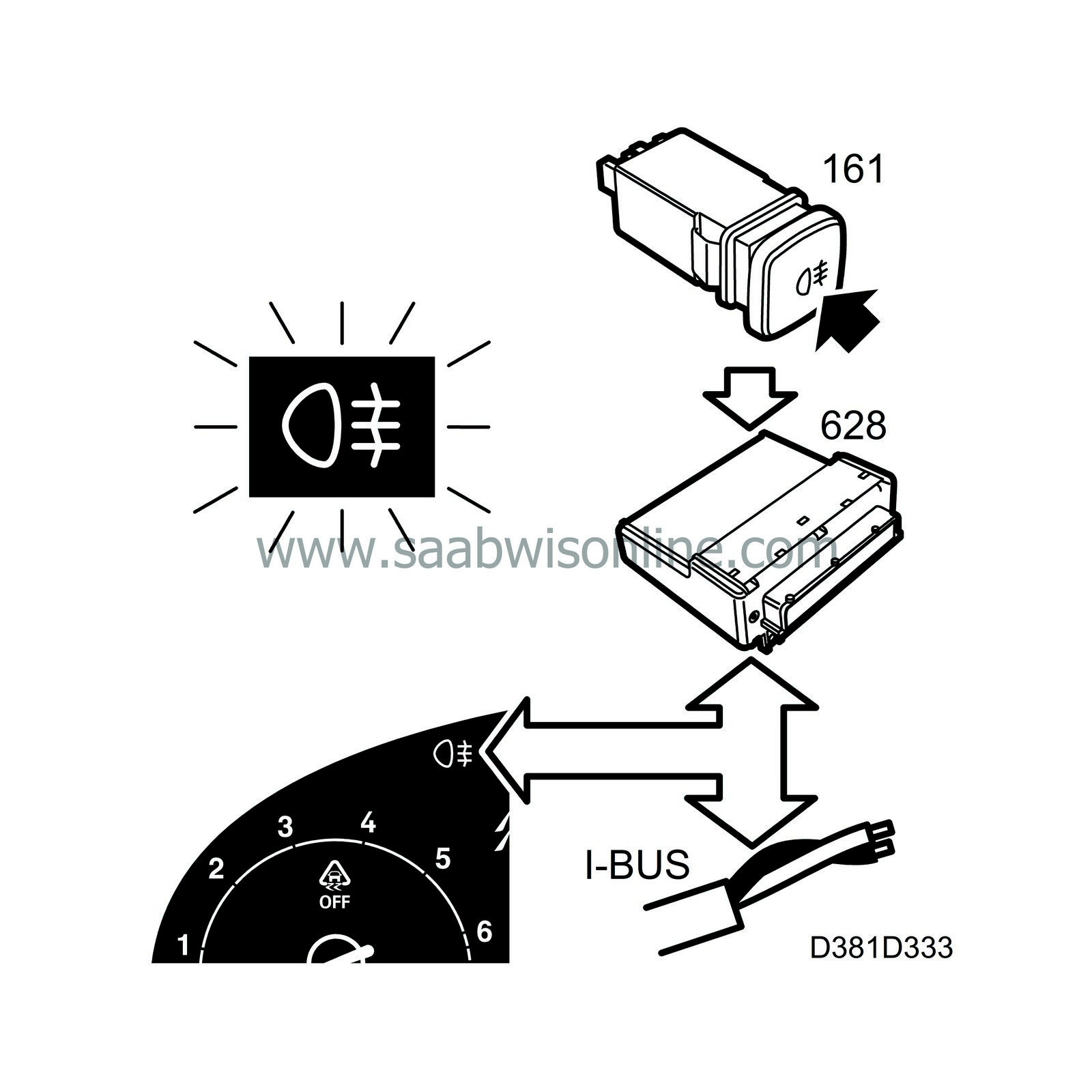
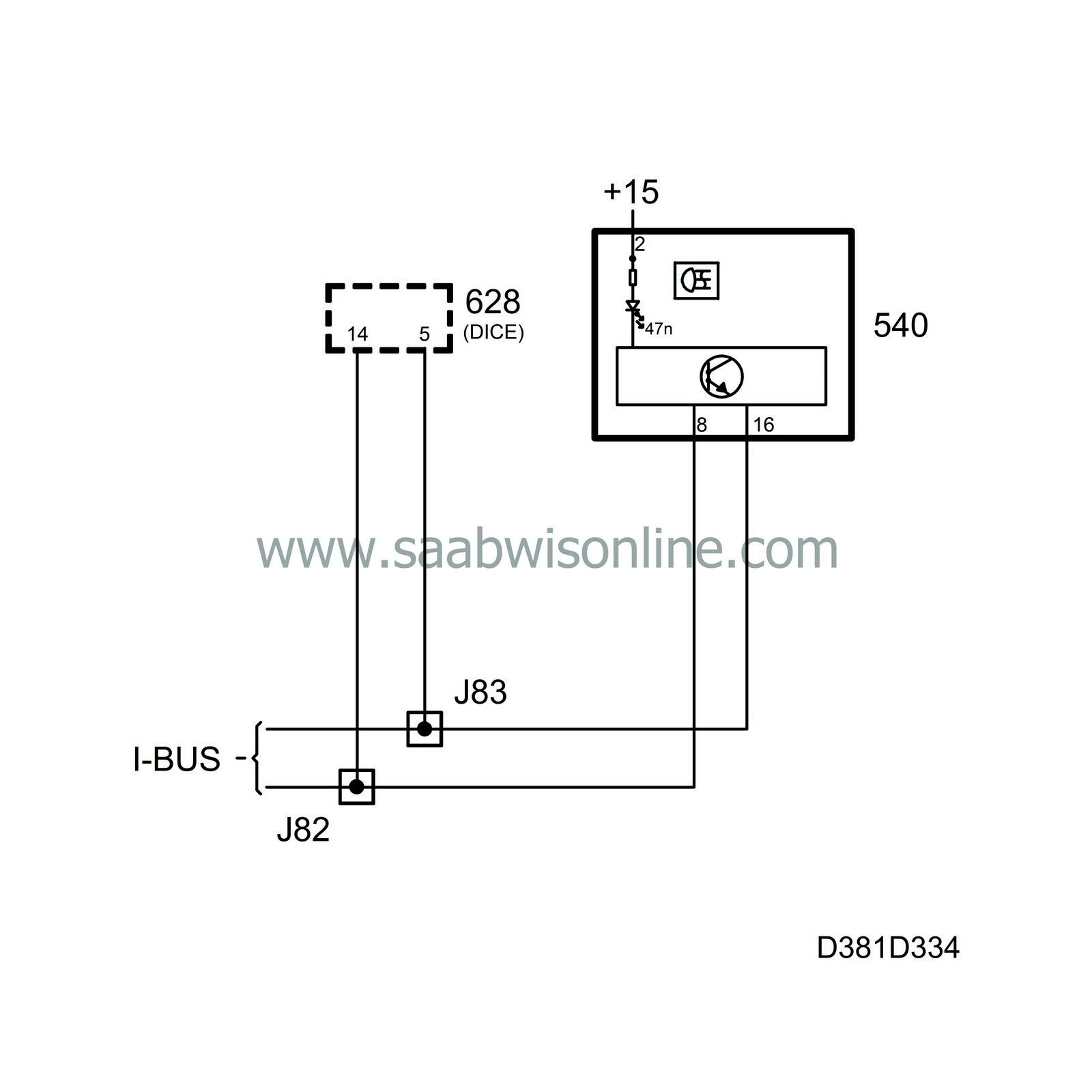
The indicator lamp for the rear fog light is situated in the upper right-hand corner and informs the driver when the rear fog light is switched on.
The lamp is powered by the main instrument unit and is grounded internally by the main instrument unit. DICE sends continuous bus information REAR FOG LIGHT, unit ON/OFF.
On receiving REAR FOG LIGHT ON, the control module grounds the output of the lamp which then lights up.
If DICE changes the status of the bus information to REAR FOG LIGHT OFF, the lamp goes out.
Diagnostics
The function has its own diagnostics in the sending system.| Main beam indicator lamp |
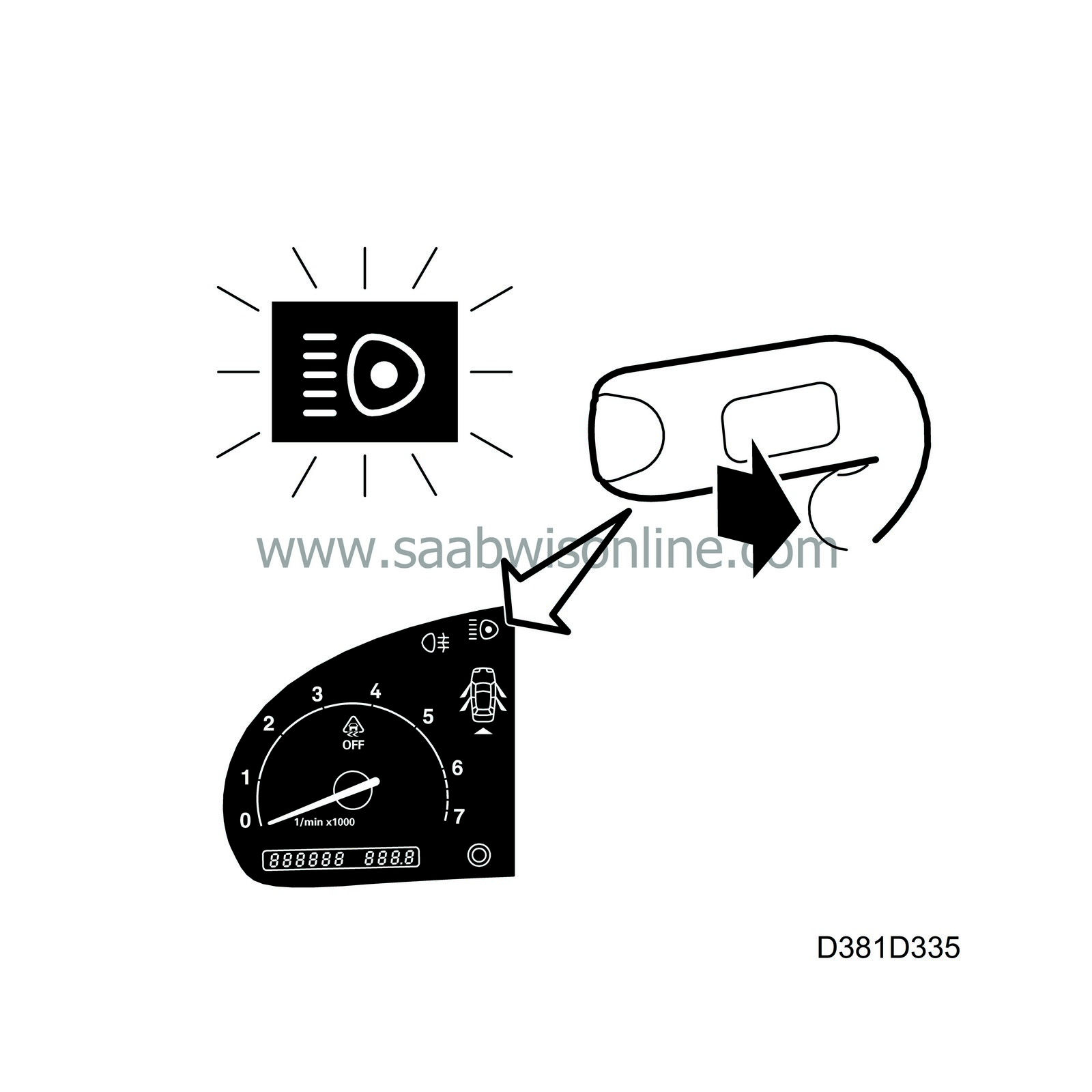
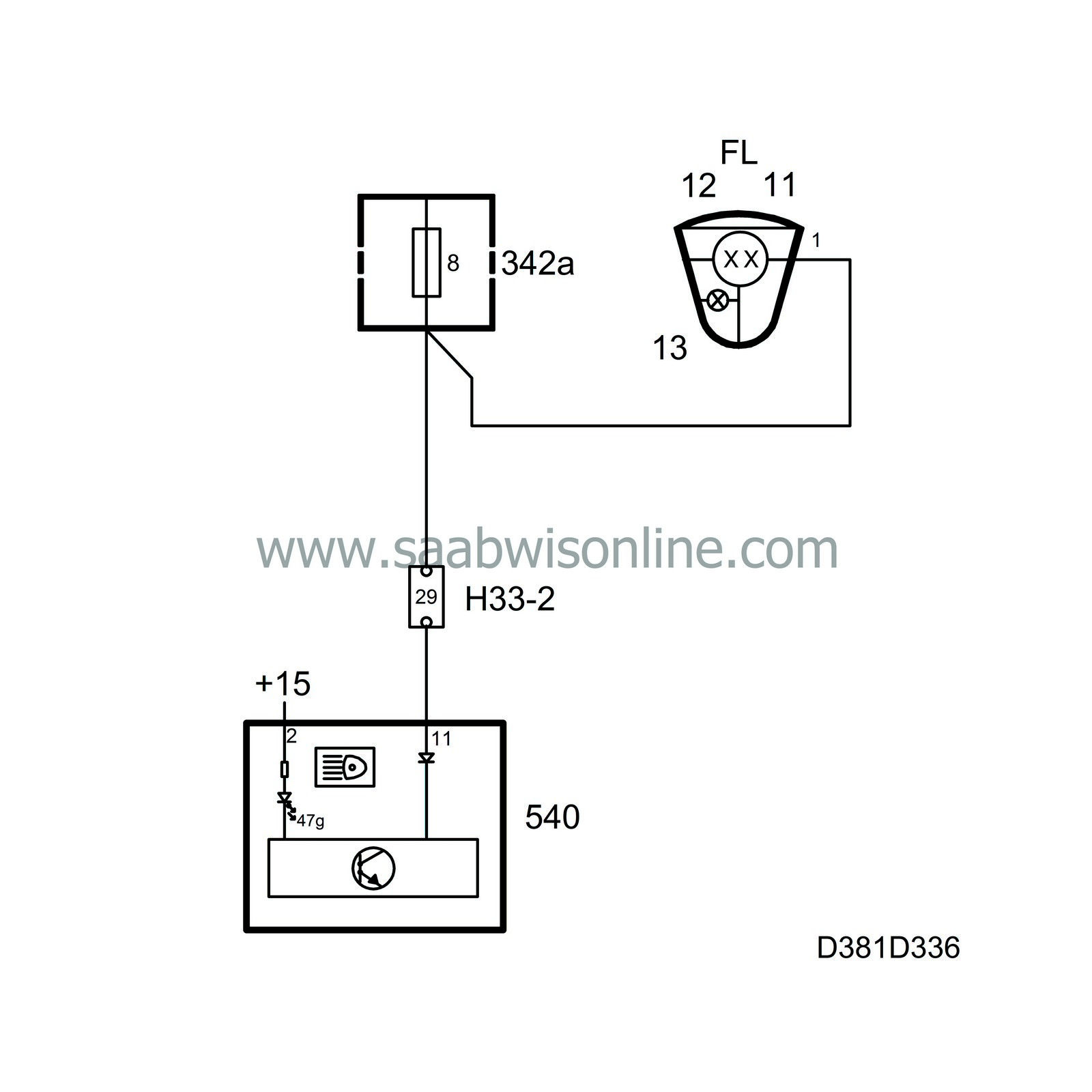
The indicator lamp is situated in the upper left-hand corner and informs the driver that main beams are switched on.
The lamp is powered by the main instrument unit and is grounded internally by the main instrument unit. The indicator lamp is turned on by the control module when the main instrument unit input (pin 11) is supplied with B+ from the main beam fuse 8.
Diagnostics
The function has no diagnostics.| Selector lever position indicator |
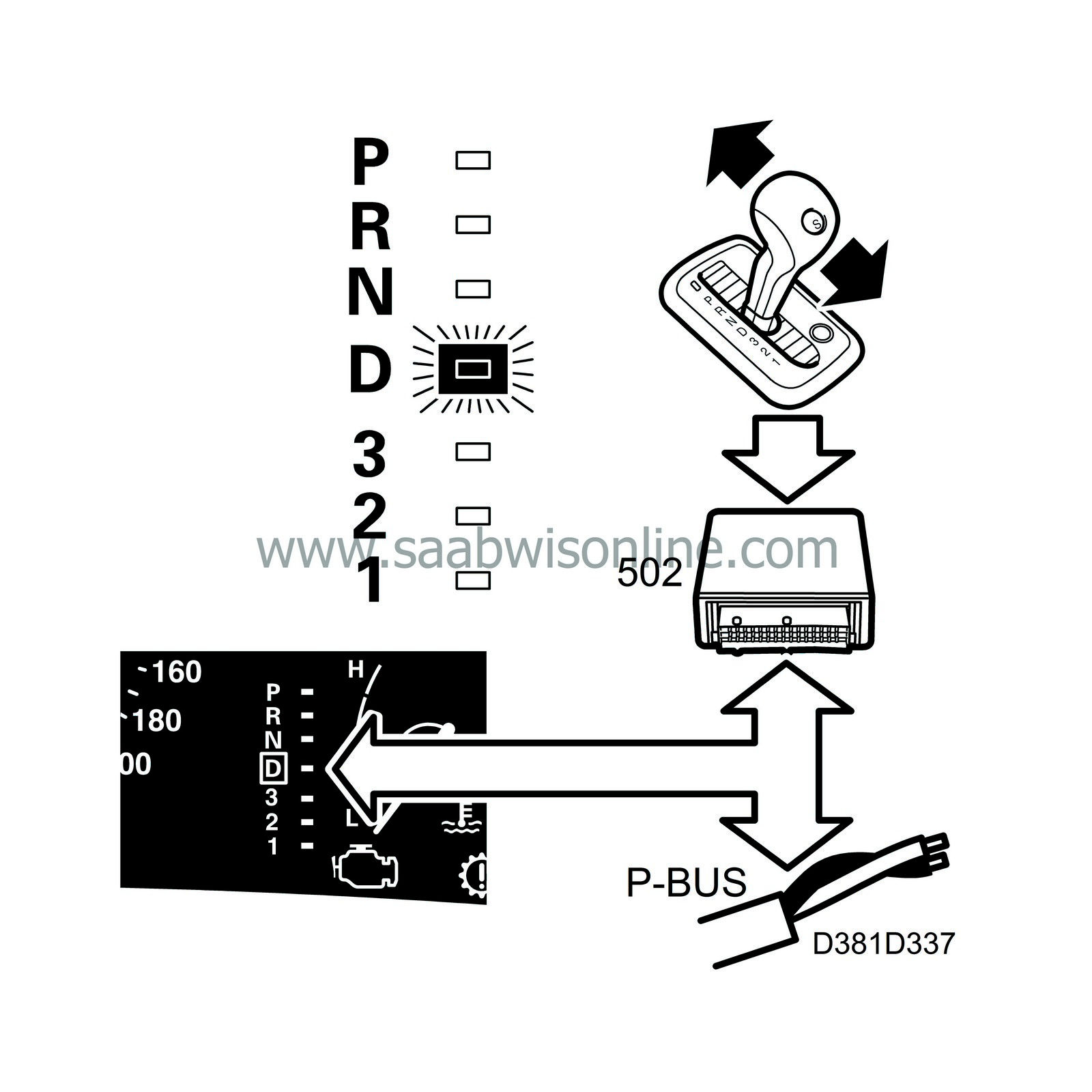

On cars with automatic transmission, the selector lever position indicator shows which gear is selected by lighting up the corresponding gear symbol.
The selector lever indicator comprises 7 segments, each with its own light emitting diode beside the respective symbol (PRND321). The symbols are illuminated with additional light emitting diodes, the brightness of which is controlled by the rheostat value.
The light emitting diodes are powered by the main instrument unit and are grounded internally by the main instrument unit. TCM sends continuous bus information on the status of all the selector lever positions, unit ON/OFF.
Example
The following information is sent when the selector lever is in P position:|
Selector lever position
|
P
|
ON
|
|
Selector lever position
|
R
|
OFF
|
|
Selector lever position
|
N
|
OFF
|
|
Selector lever position
|
D
|
OFF
|
|
Selector lever position
|
3
|
OFF
|
|
Selector lever position
|
2
|
OFF
|
|
Selector lever position
|
1
|
OFF
|
The main instrument unit control module grounds the output to the P symbol LED, which then comes on while all the others remain off. If another selector lever position is selected, the status of the bus information will be changed, turning off the symbol that was on previously and turning on the symbol for the new selector lever position.
Diagnostics
The function has its own diagnostics in the sending system.| Door indication |
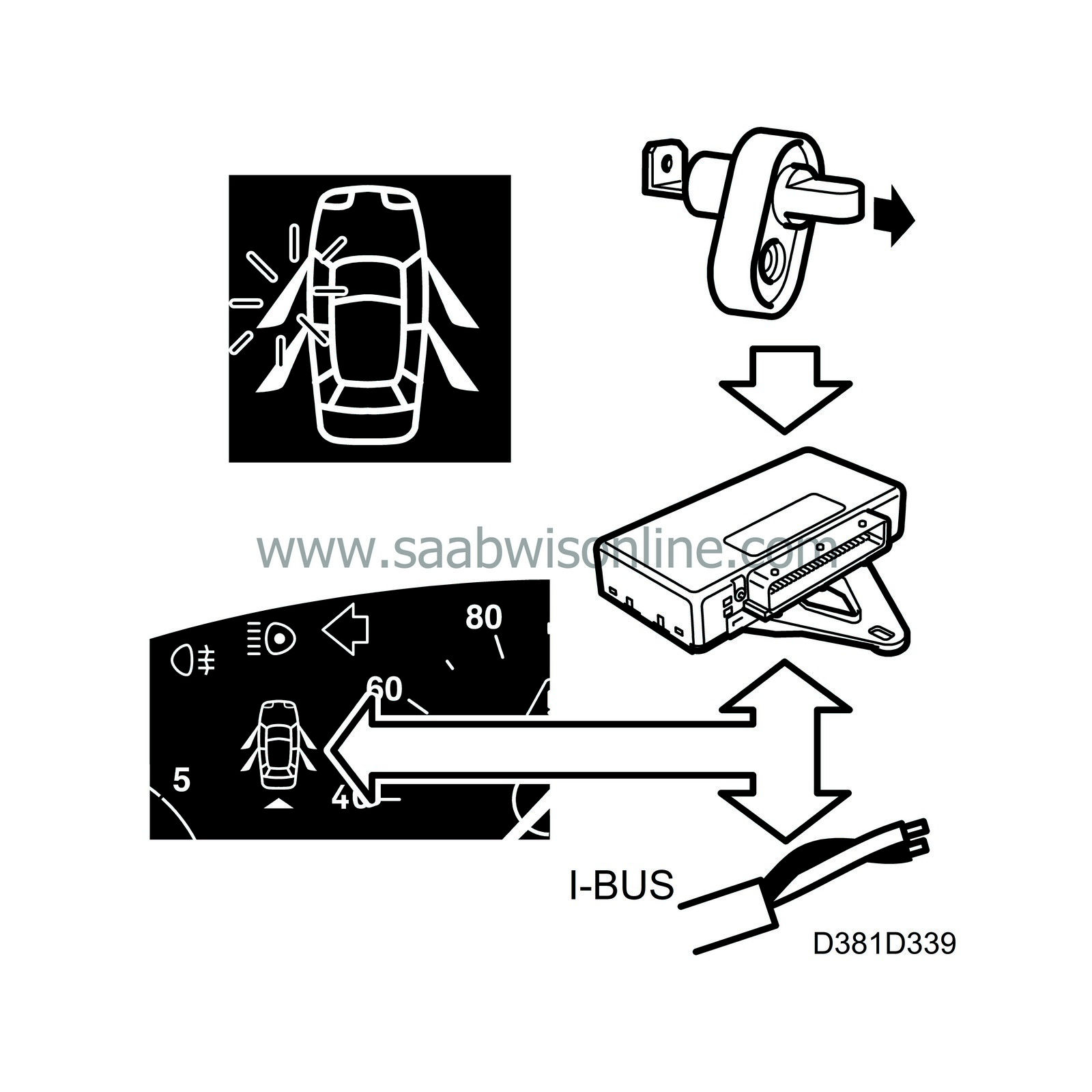
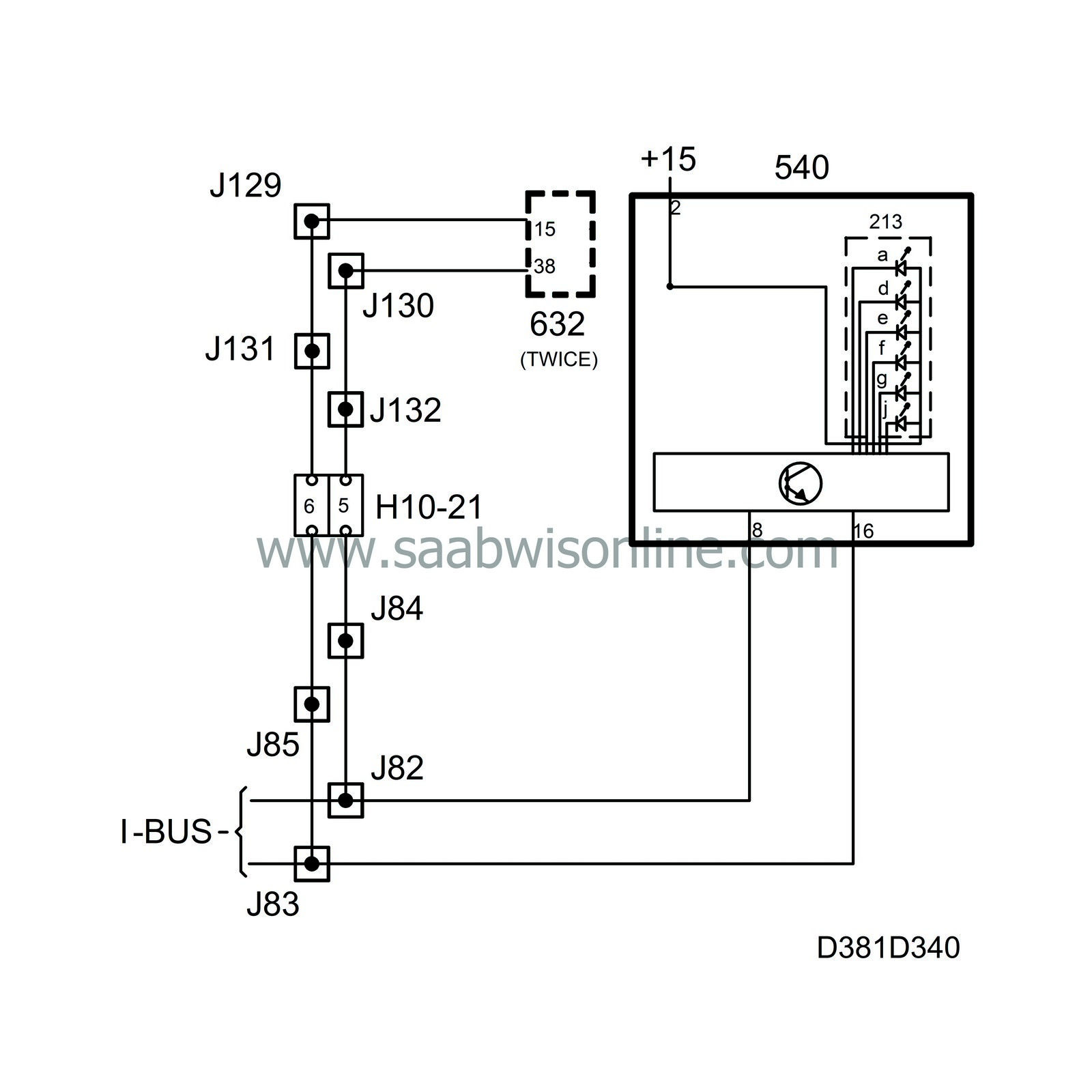
Door indication (on the pictogram) informs the driver if any of the doors or the tailgate is open. It consists of five red LEDs and a lamp. The doors and the tailgate each have an LED. The car is indicated in orange by a lamp.
The LEDs and the lamp are powered by the main instrument unit and are grounded internally by the main instrument unit.
TWICE continuously sends bus information on the status of the doors and tailgate, unit OPEN/CLOSED.
Example
When the driver's door is open and the other doors and tailgate are closed, the following information is sent:|
Driver's door
|
Open
|
|
|
Passenger's door
|
Closed
|
|
|
Rear door LH
|
Closed
|
|
|
Rear door RH
|
Closed
|
|
|
Tailgate
|
Closed
|
The main instrument unit control module grounds the outputs of the symbols for the driver's door and the car, which then light up. The other LEDs remain off. The car symbol always lights up if a door or the tailgate is open.

